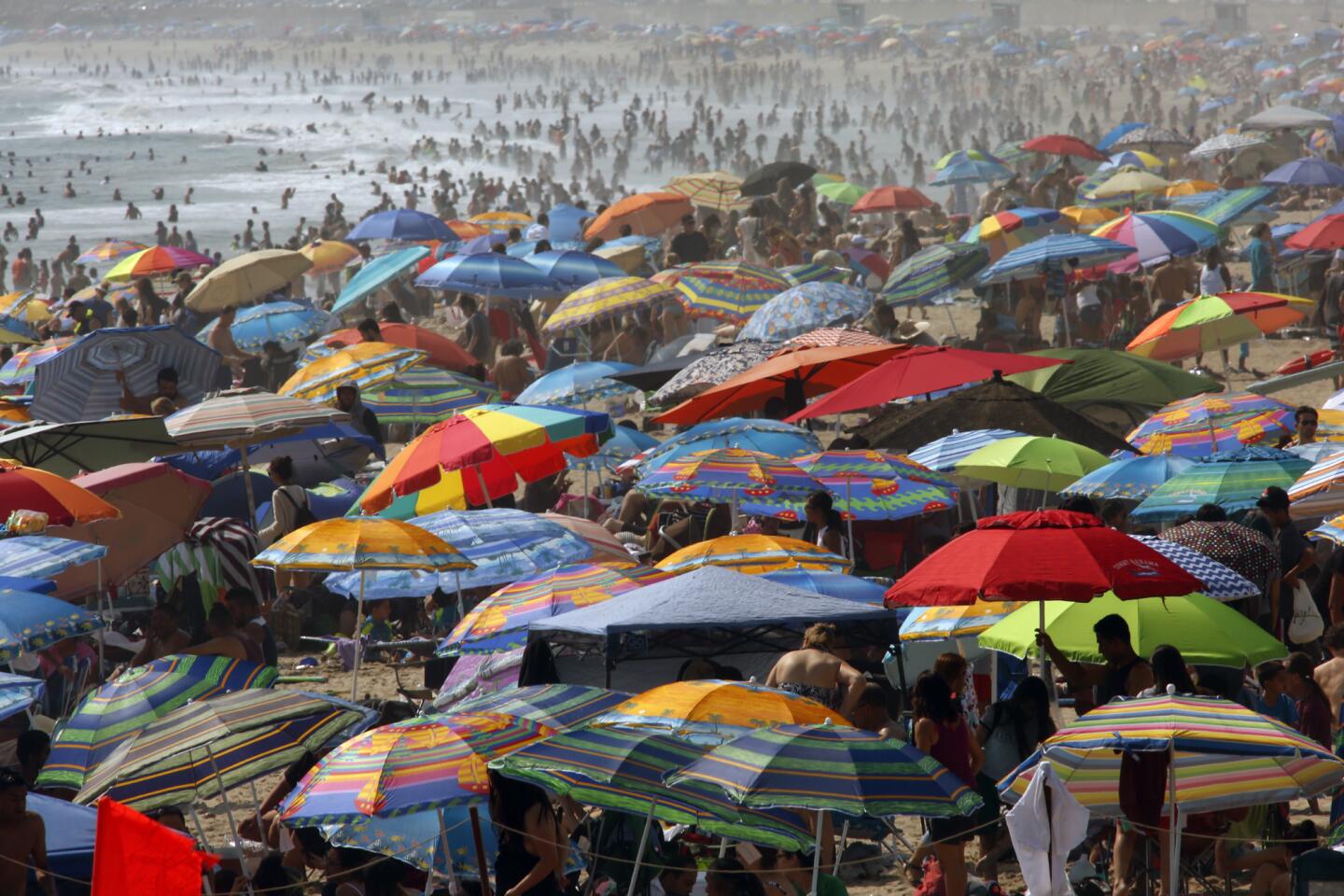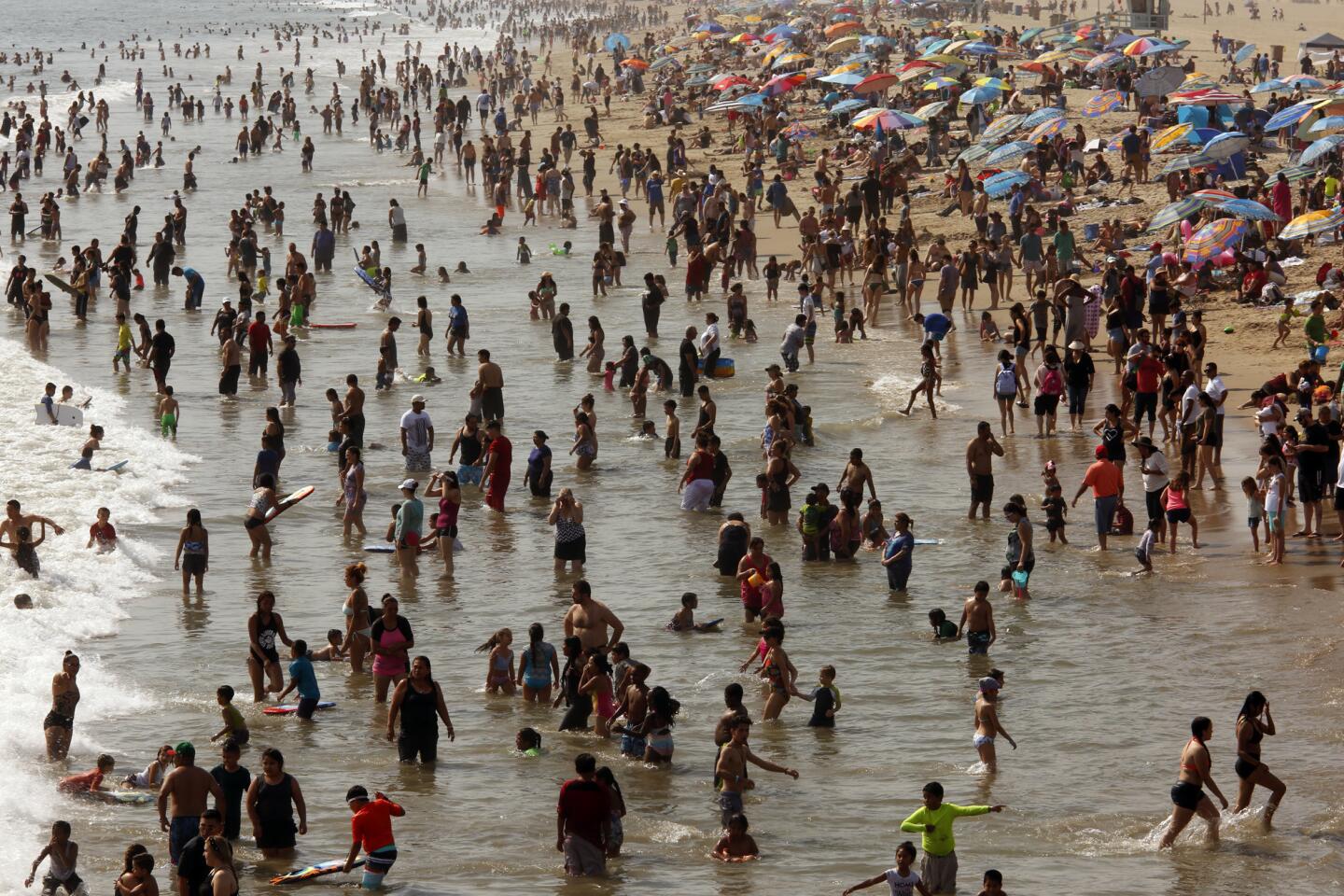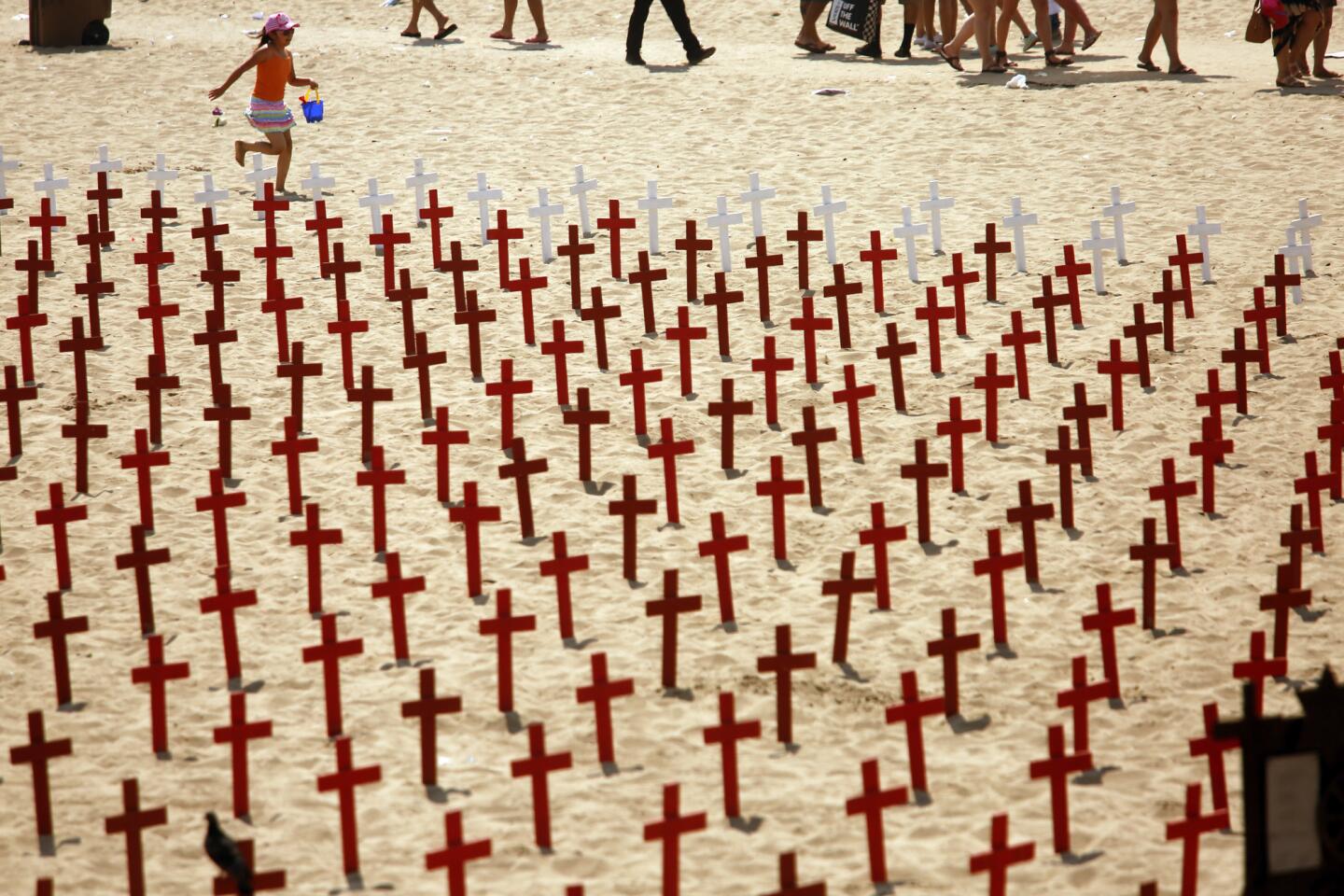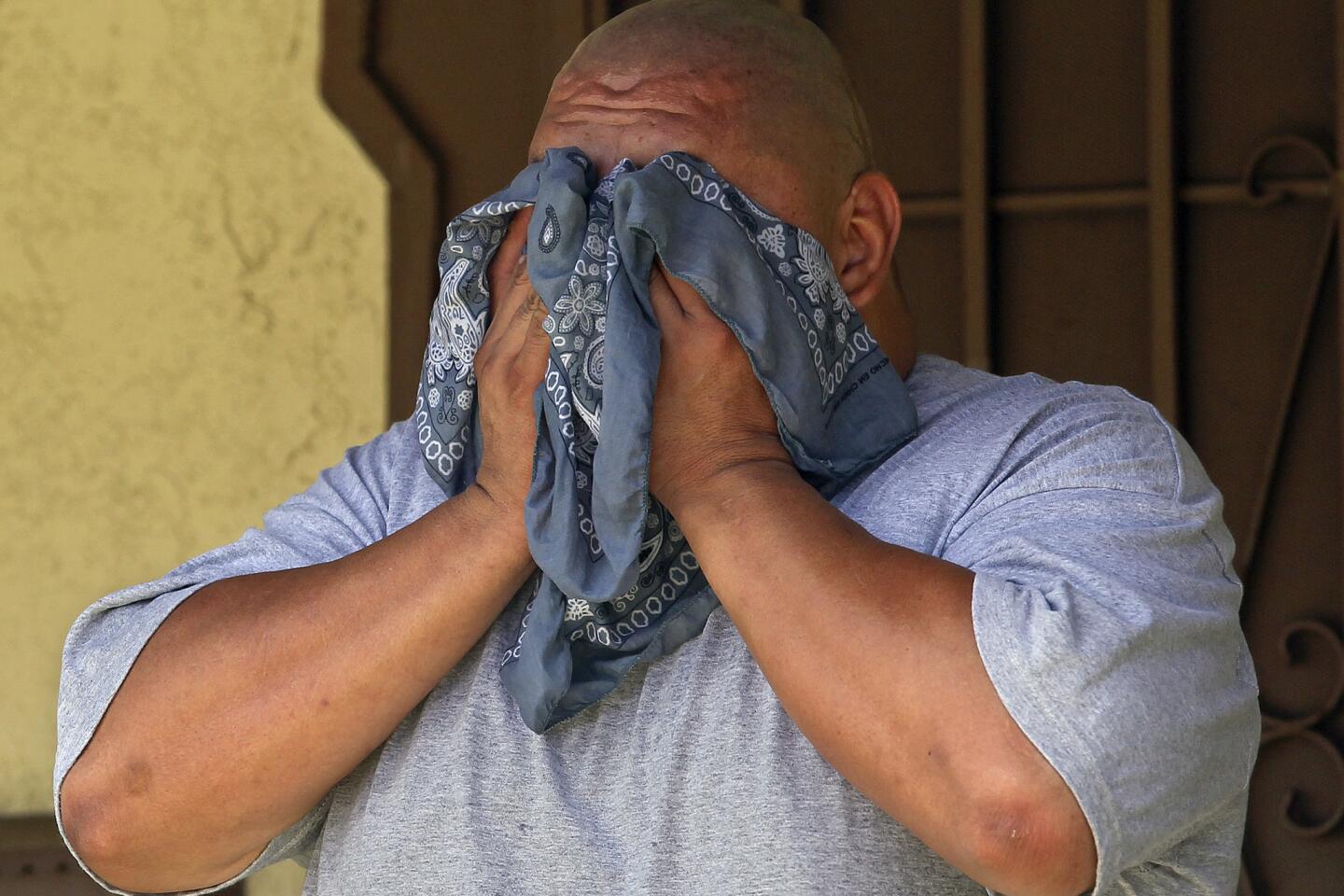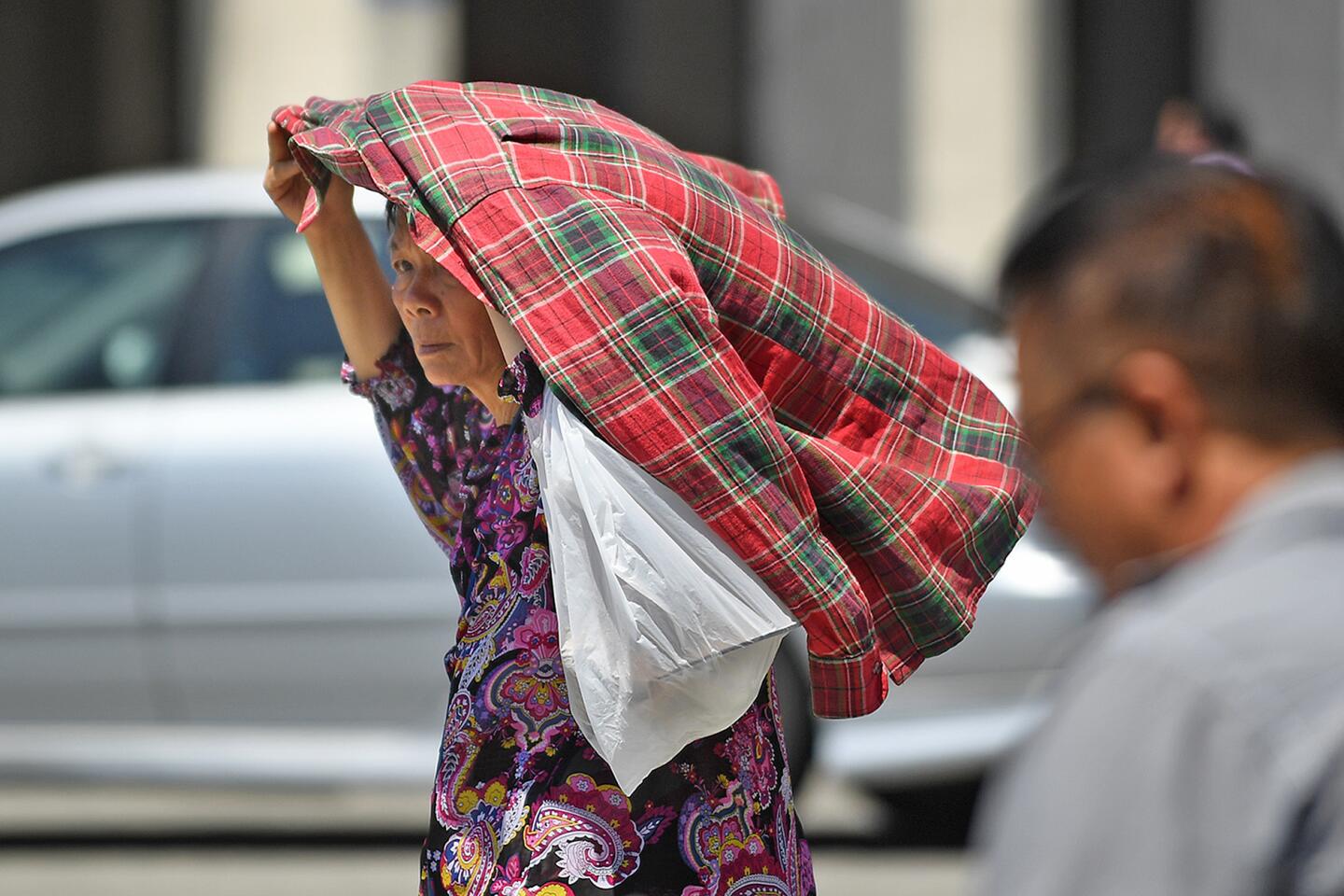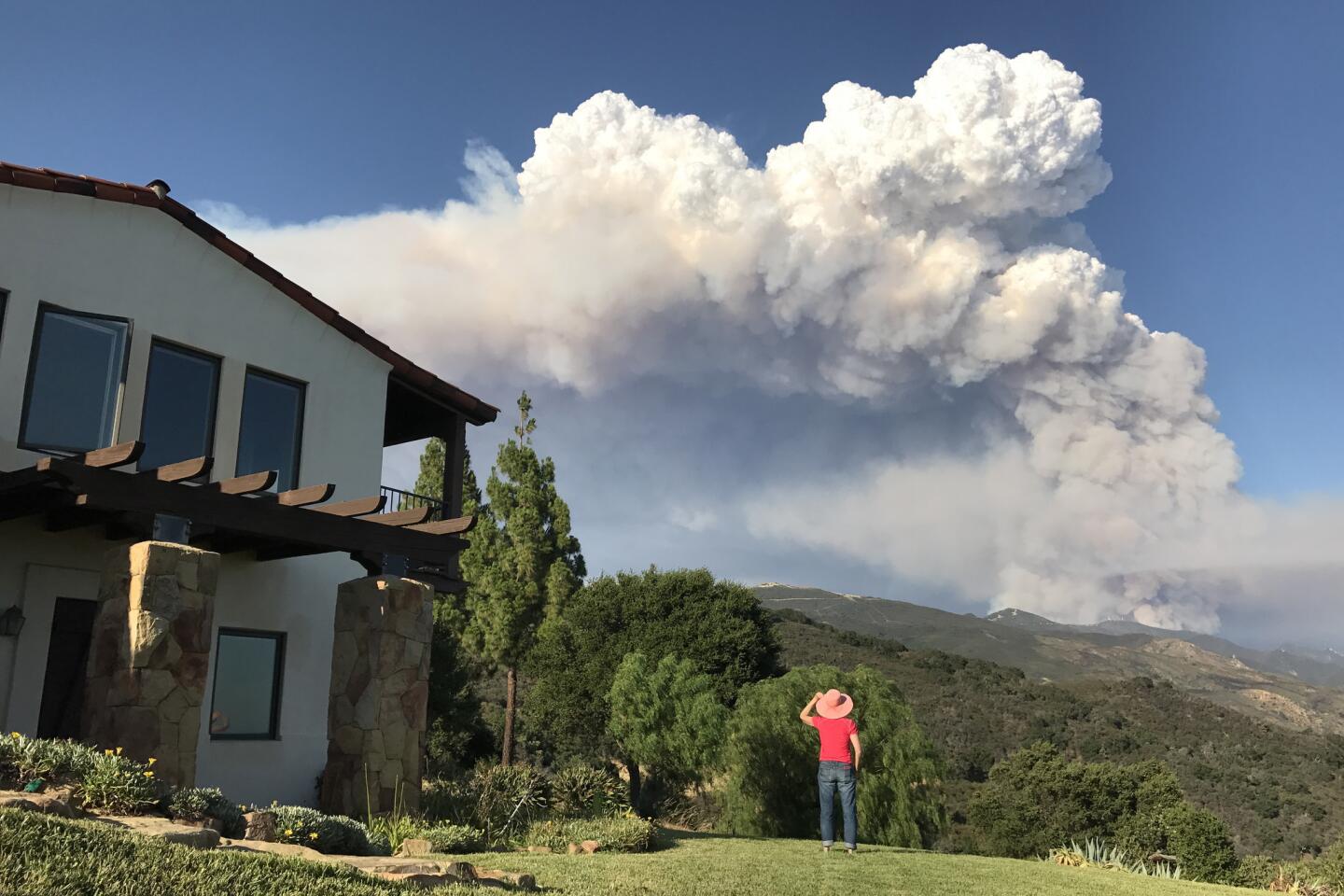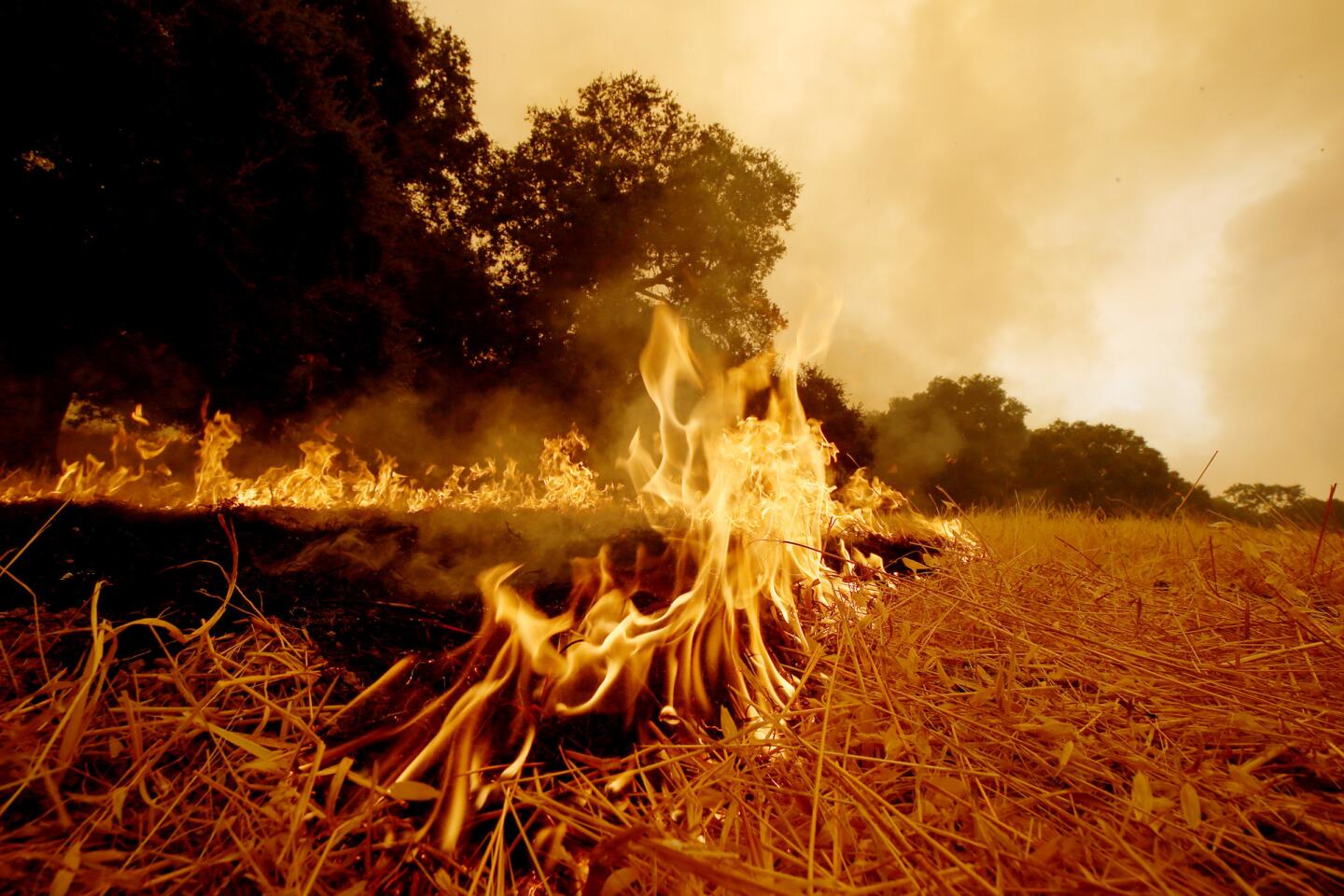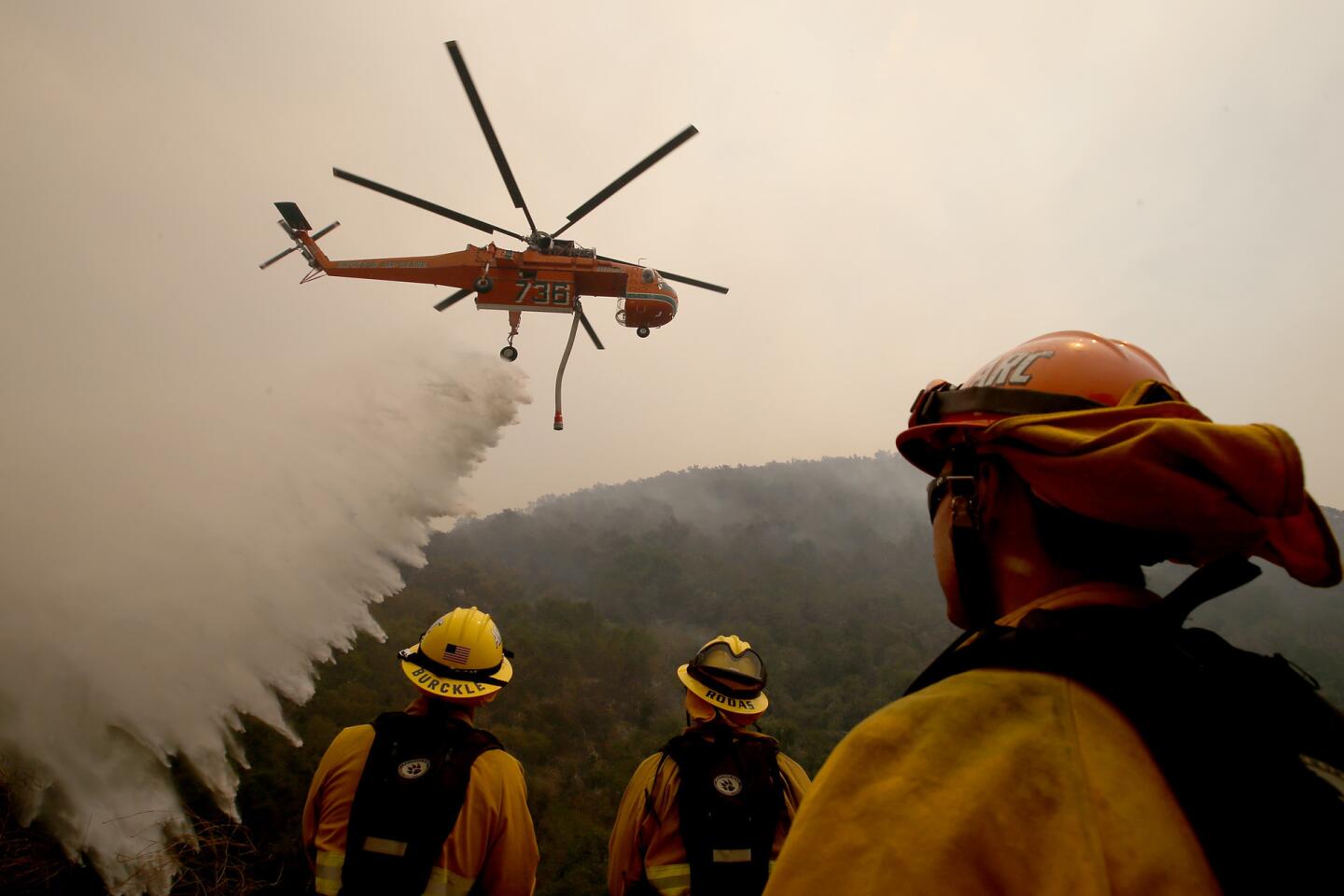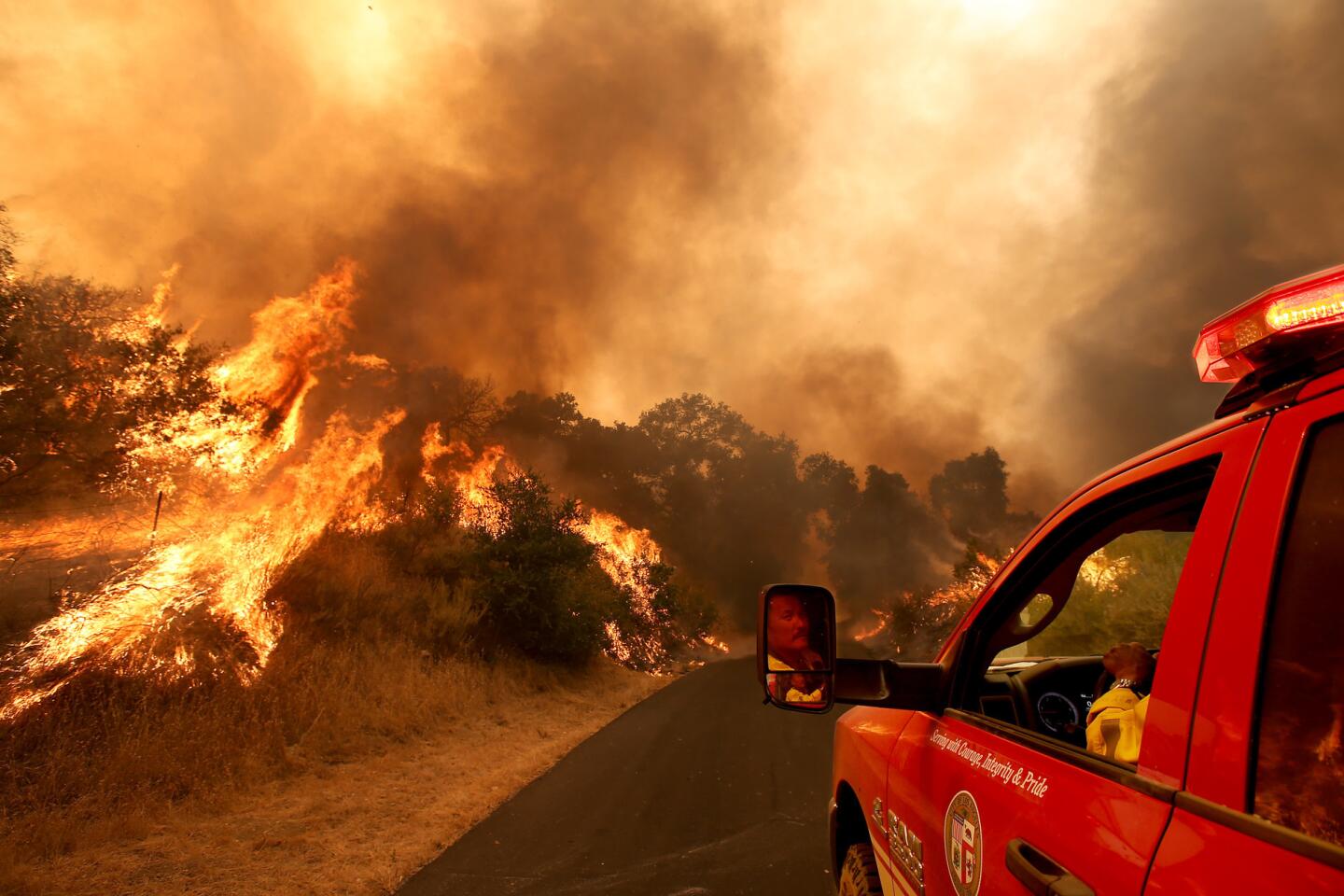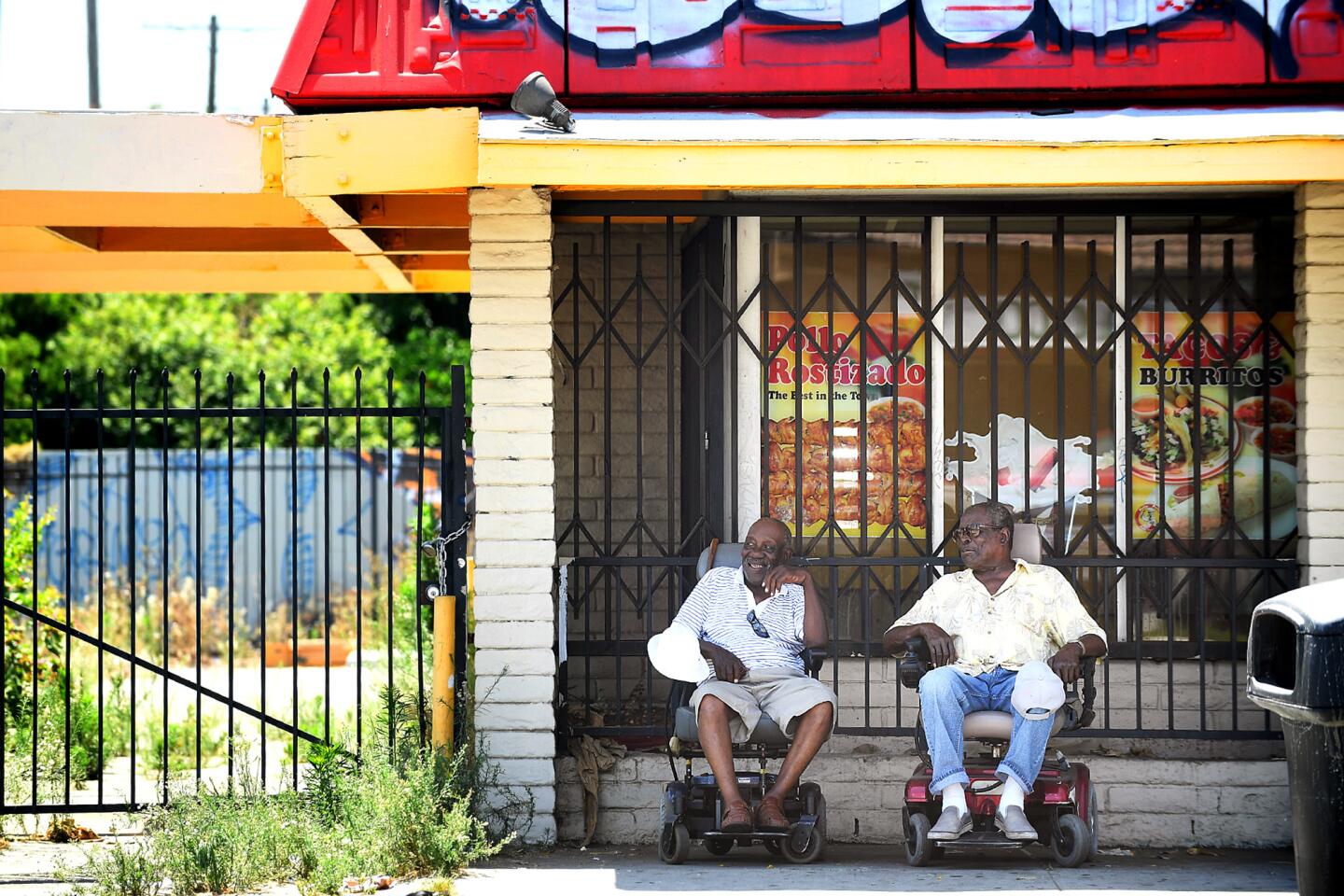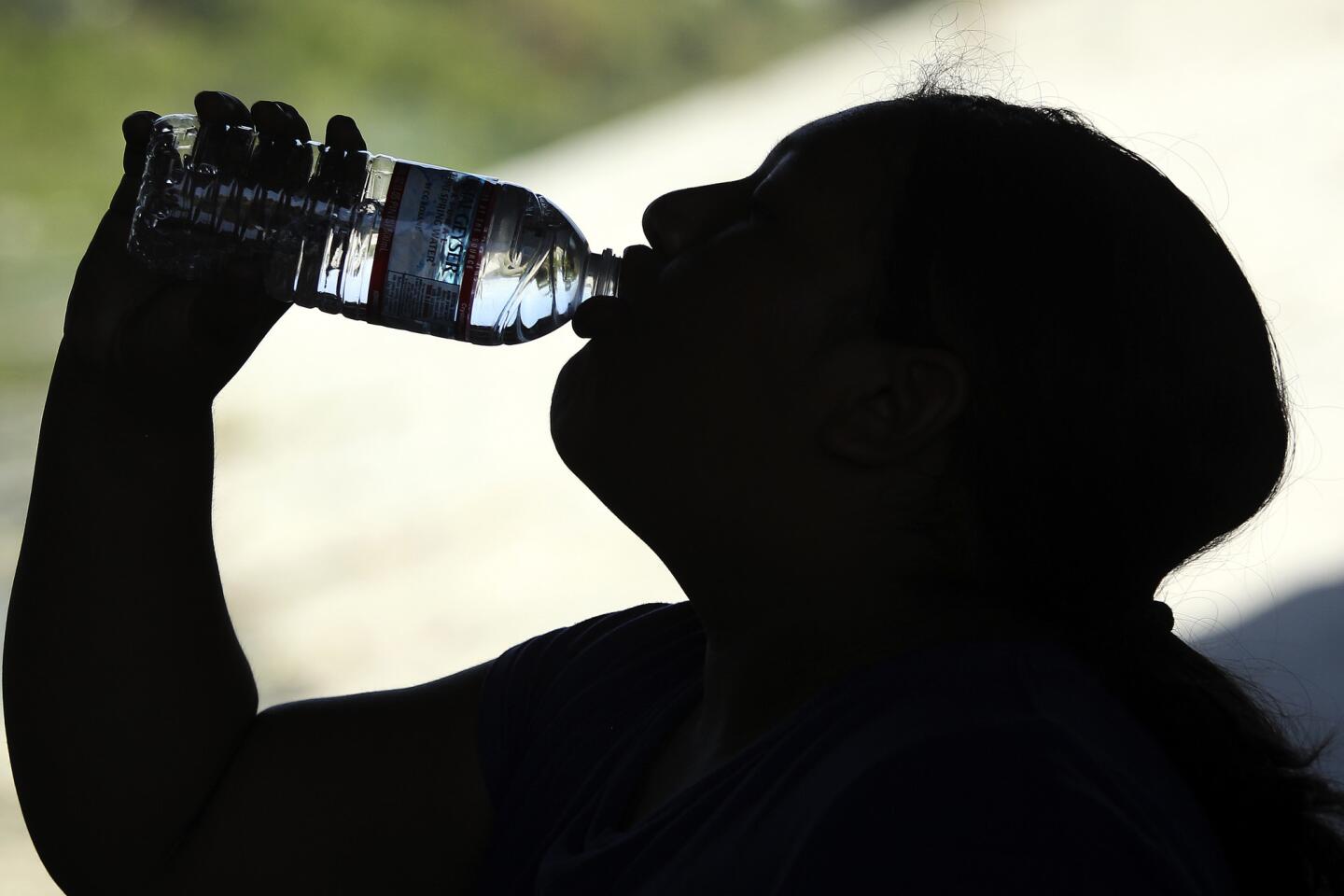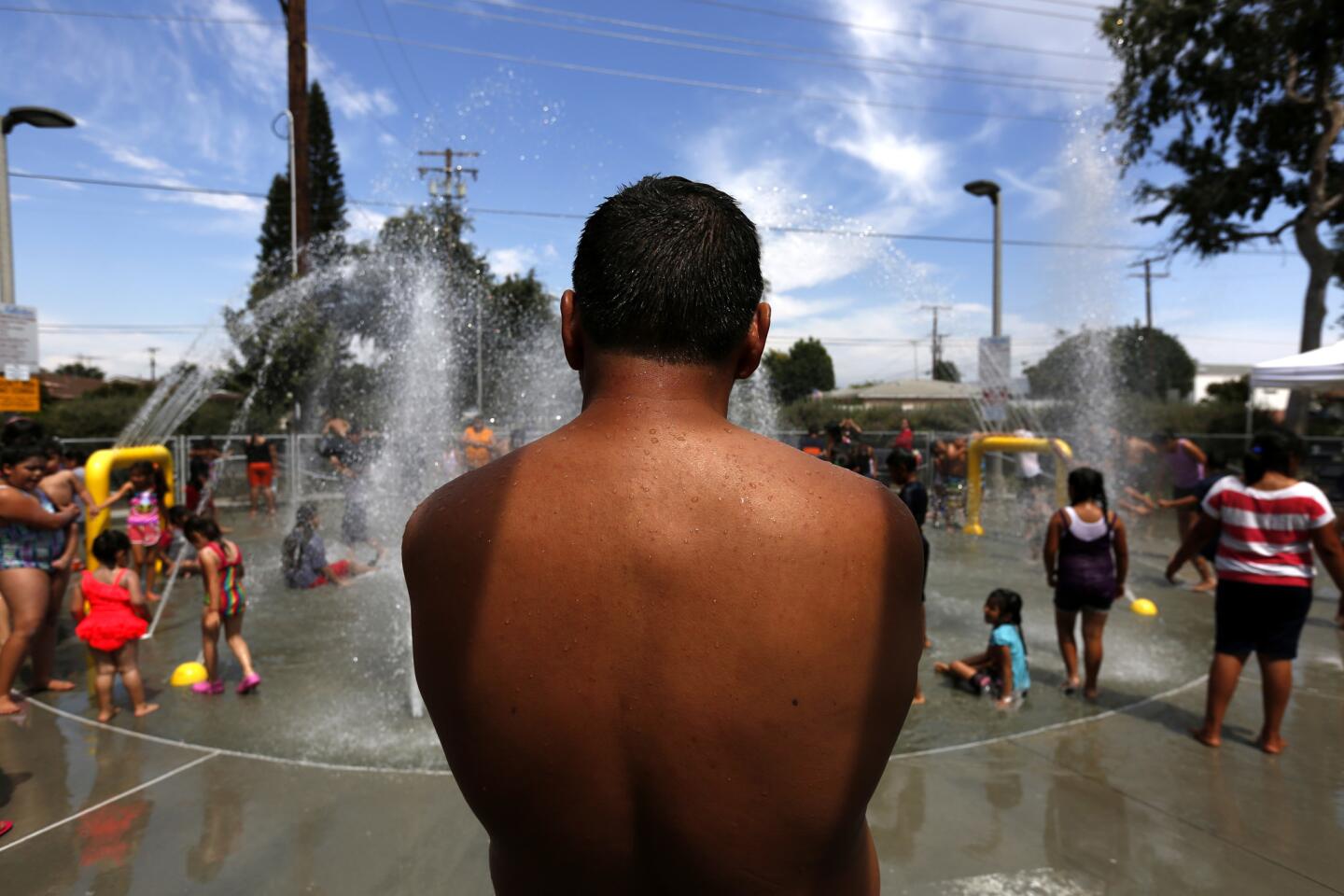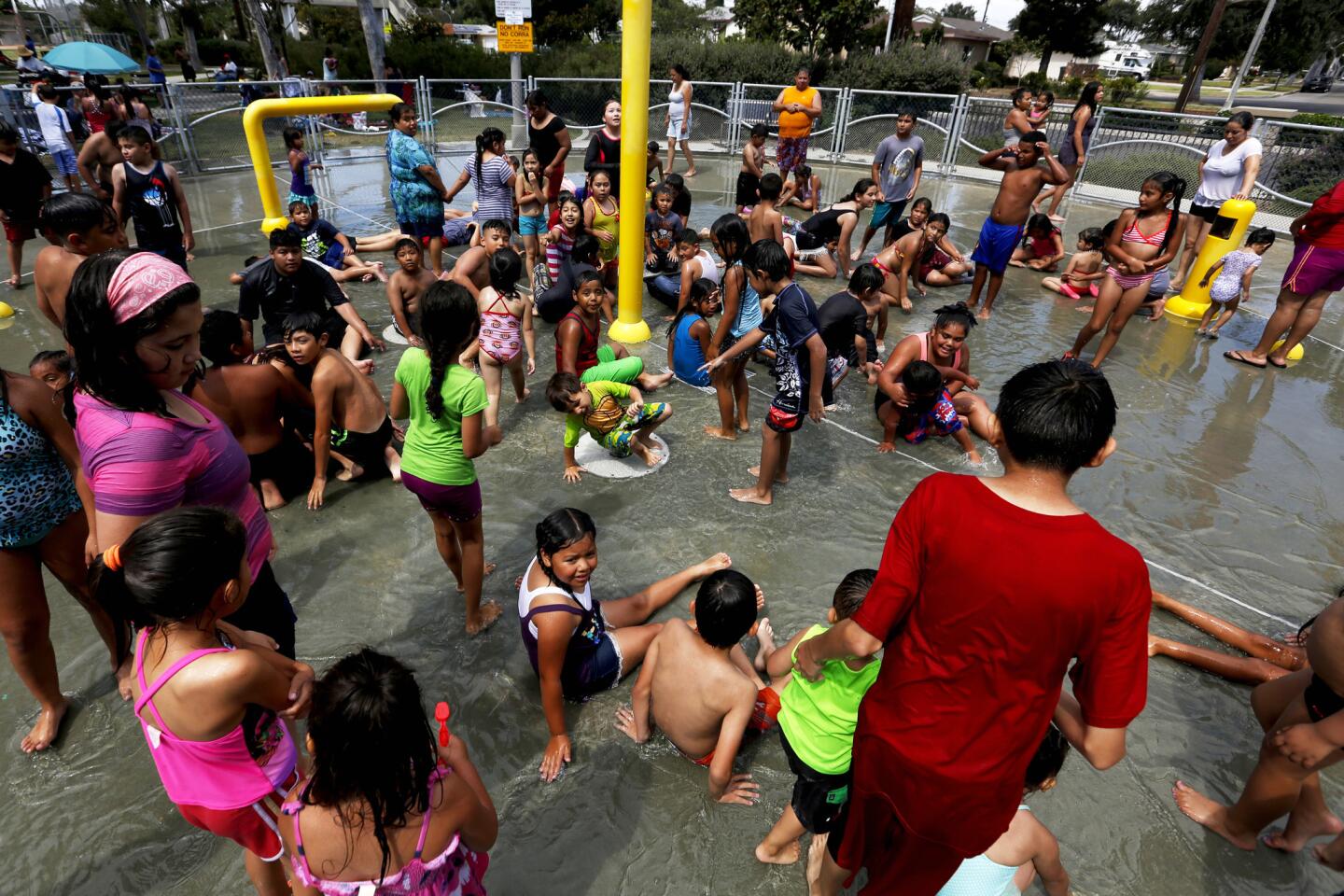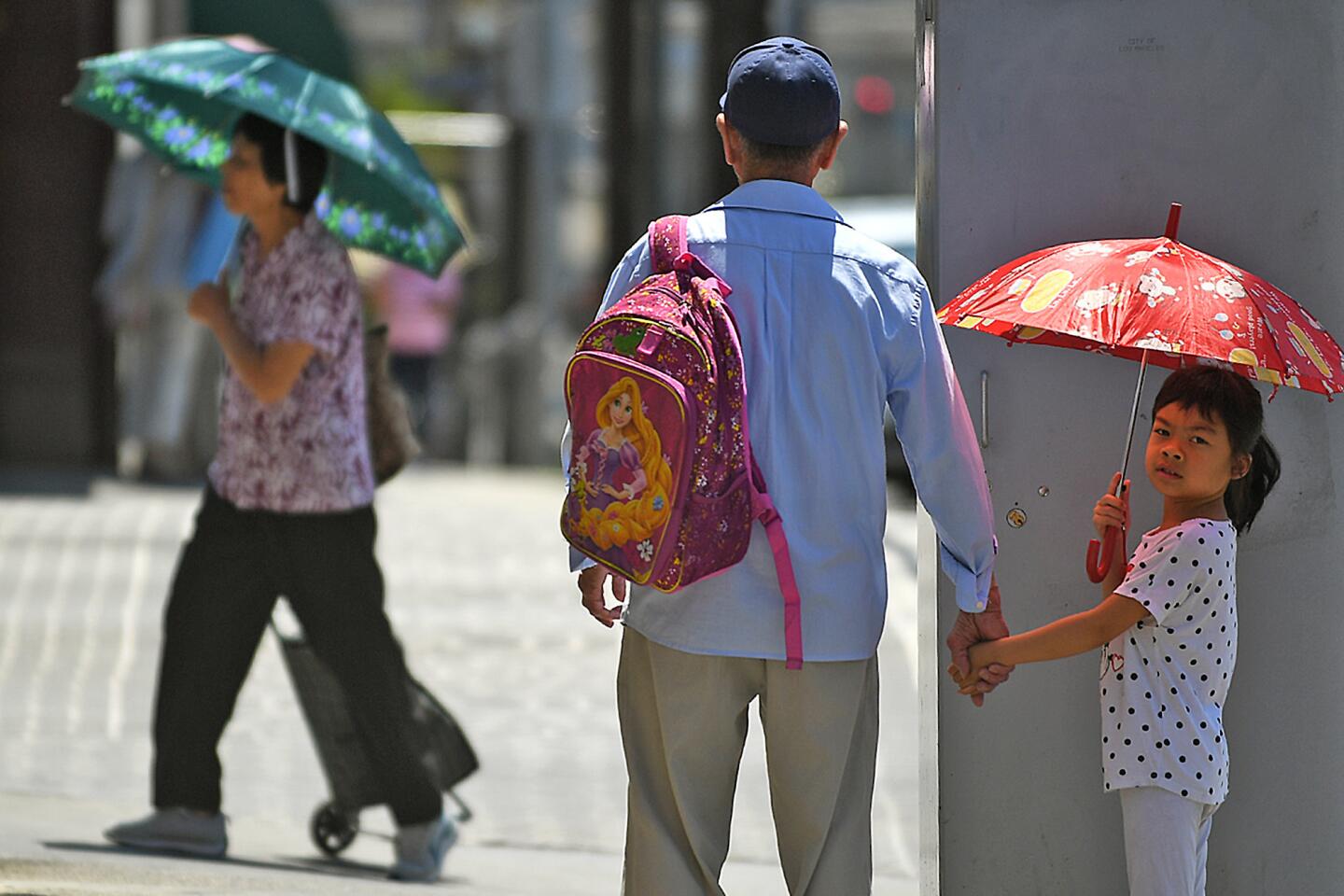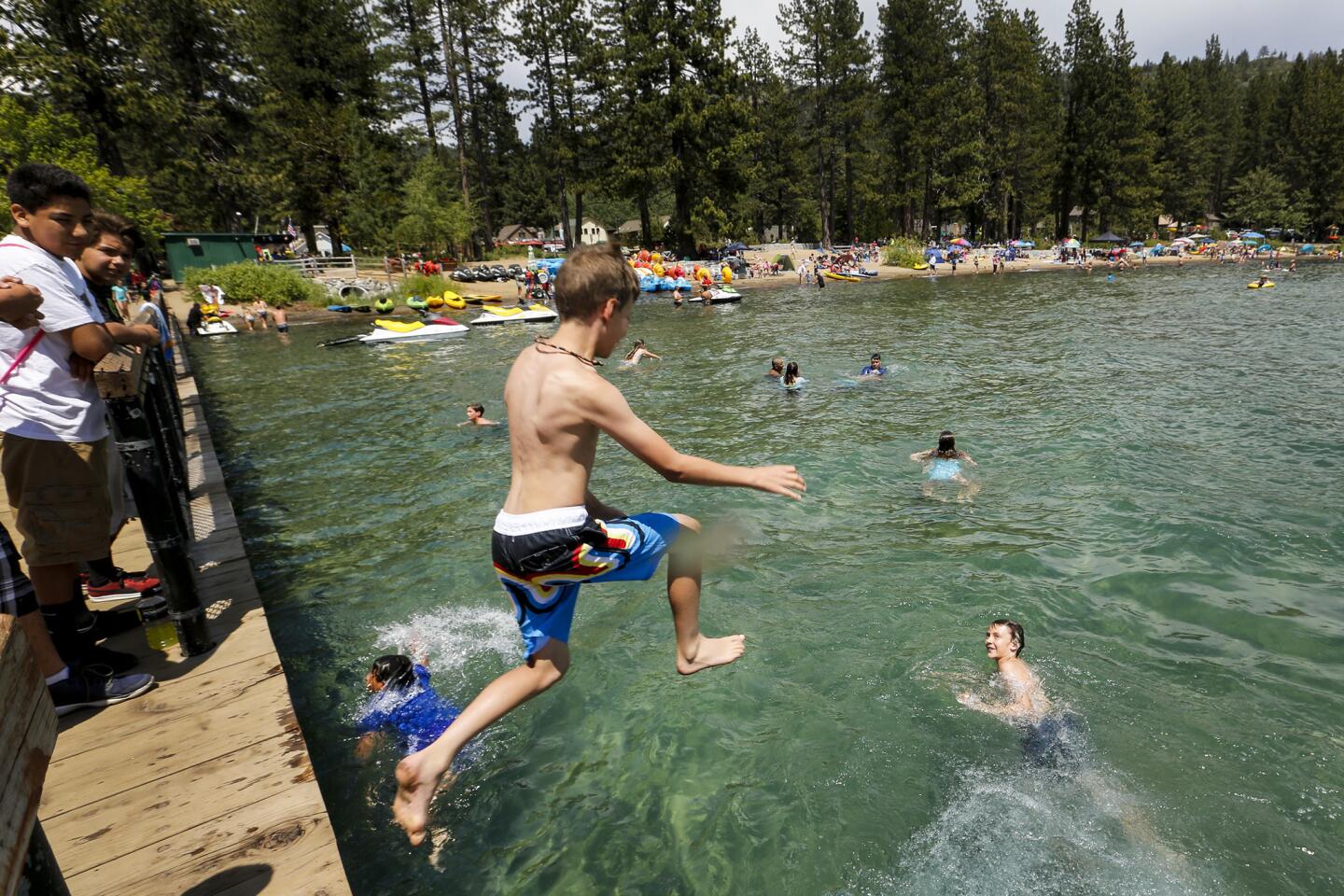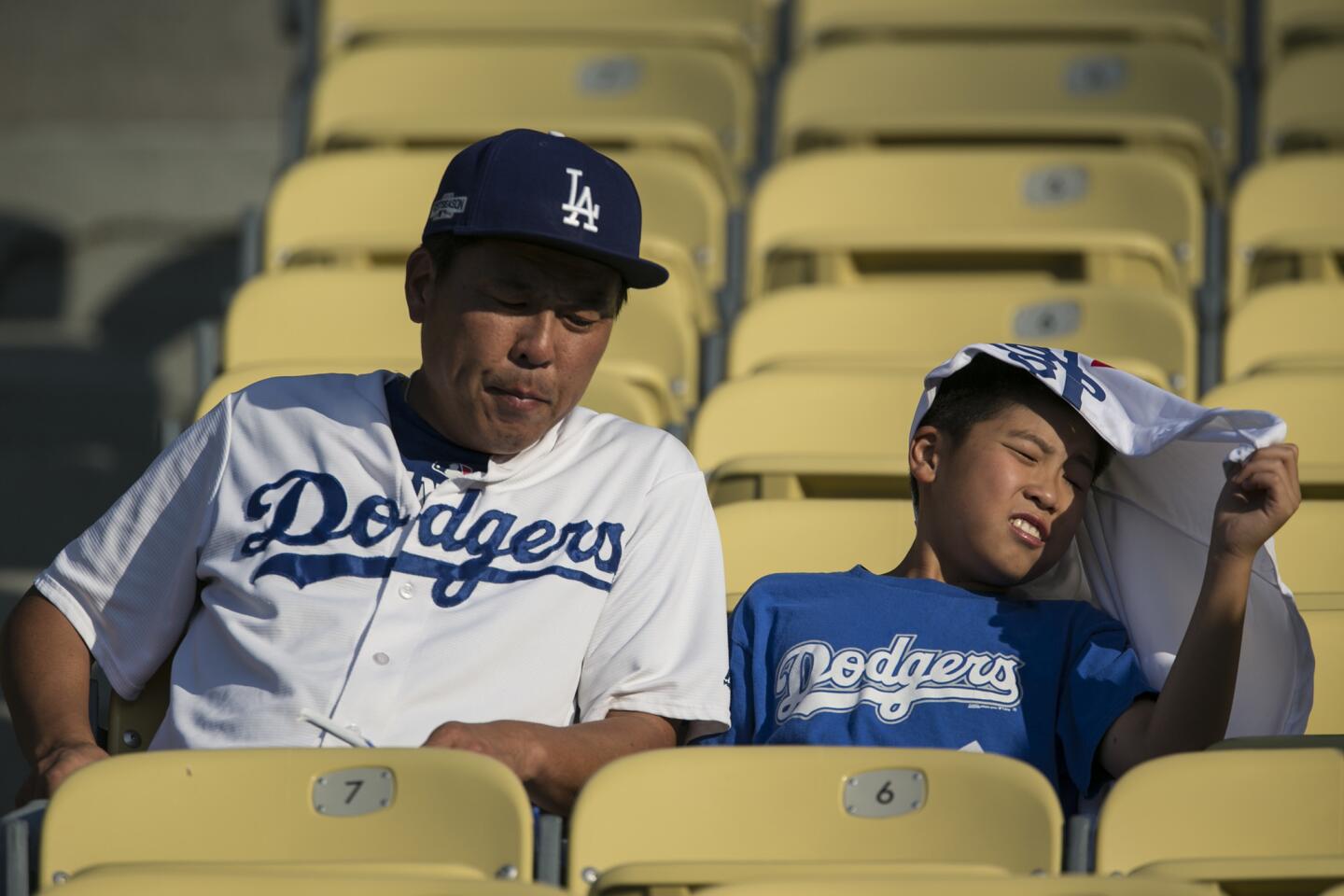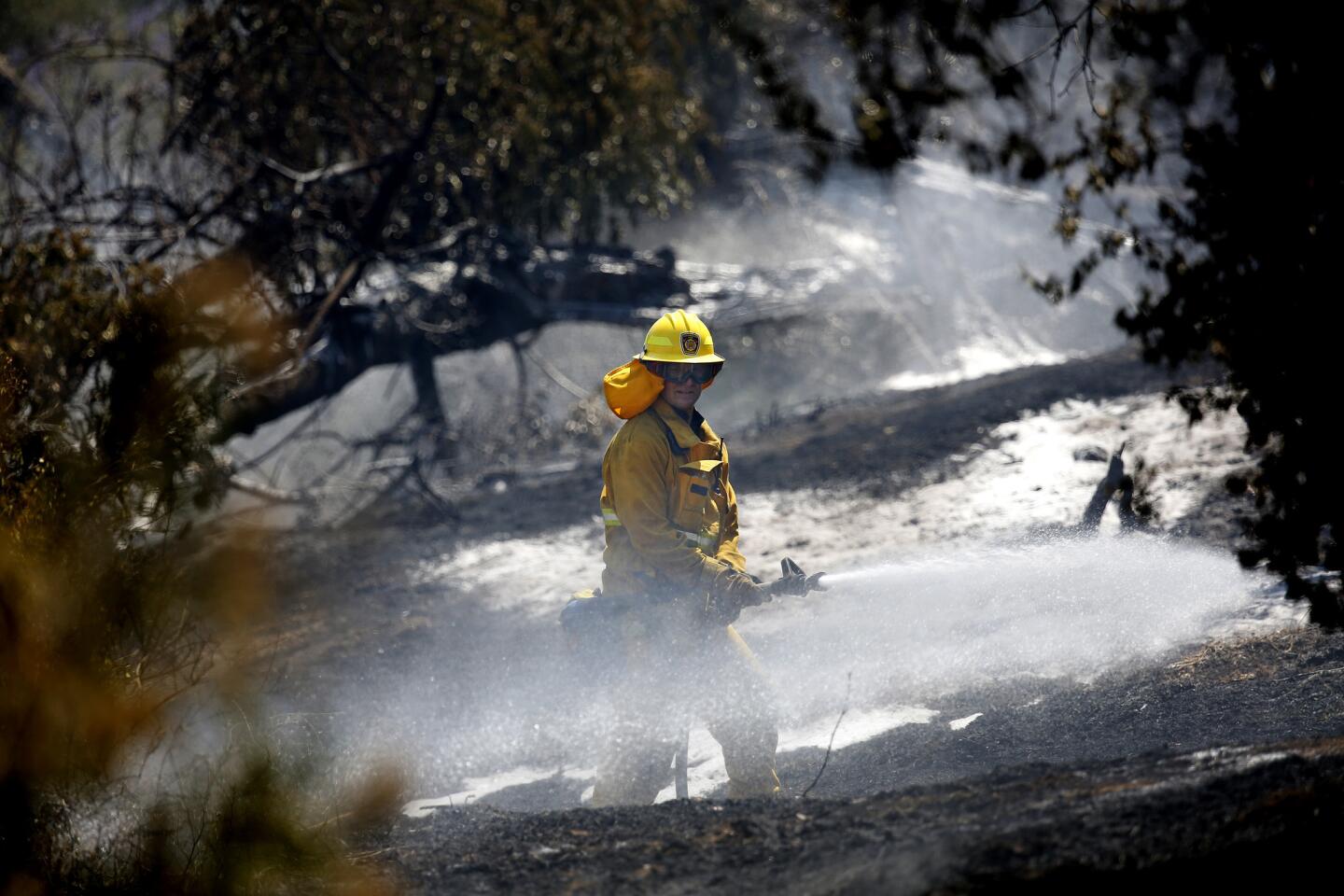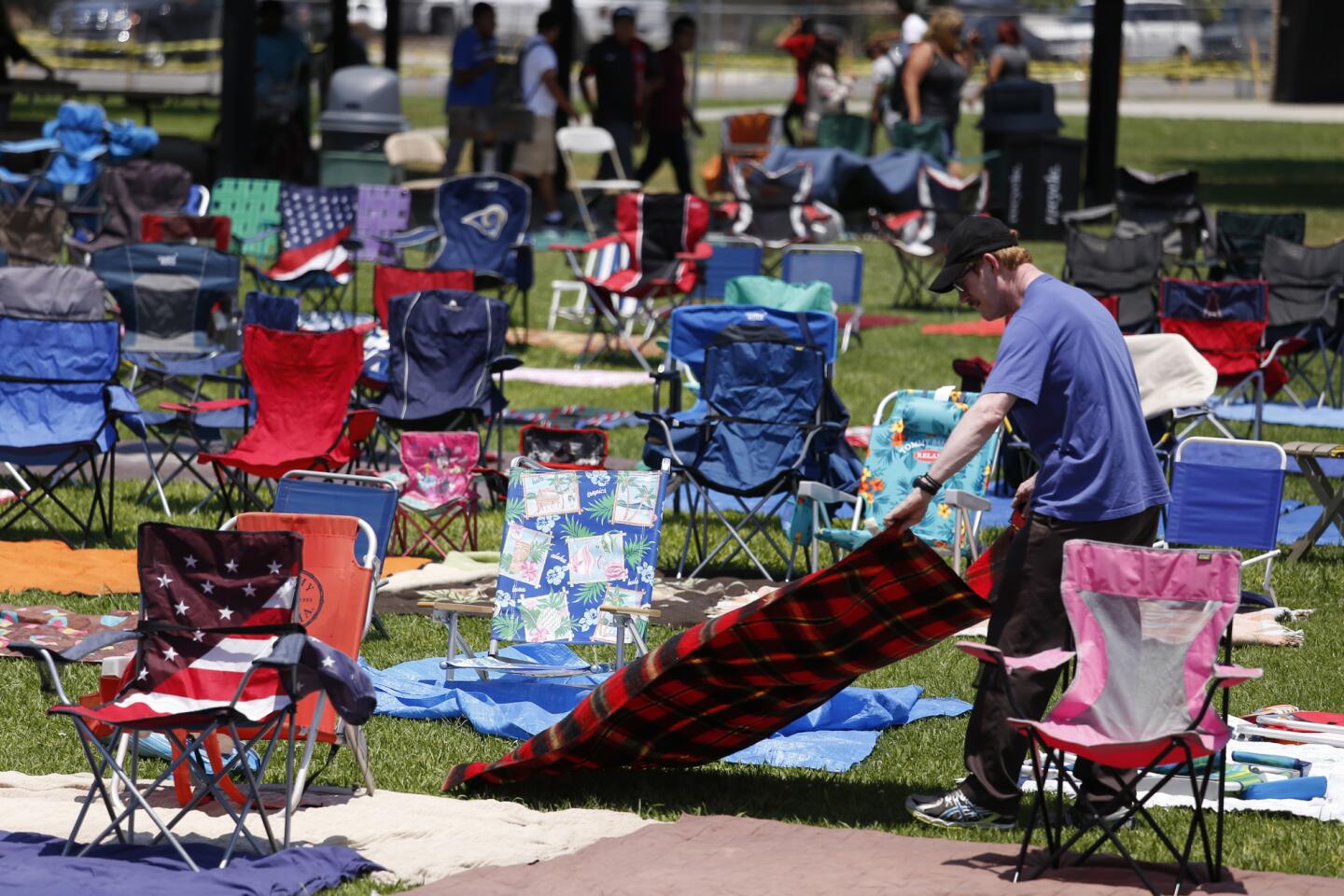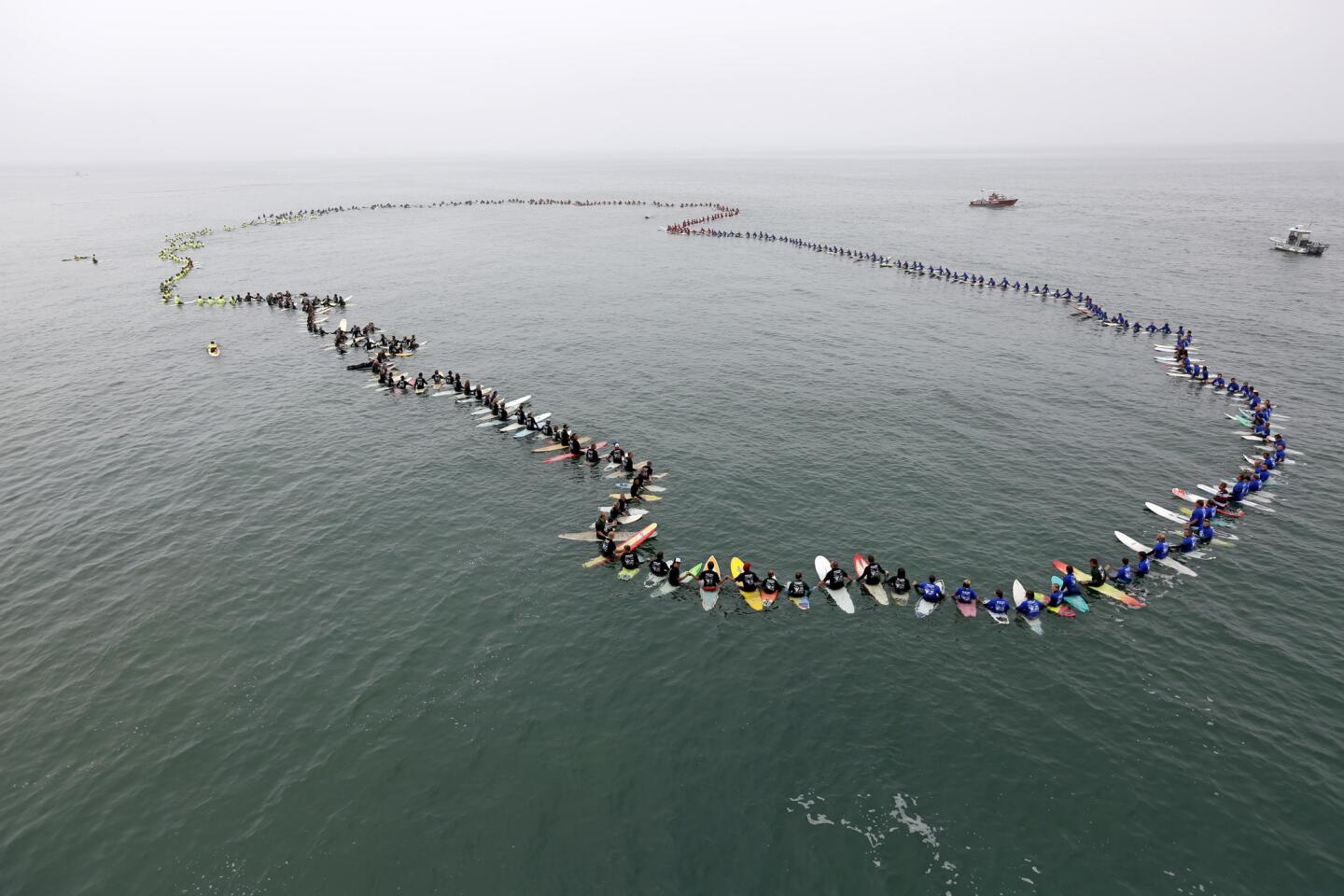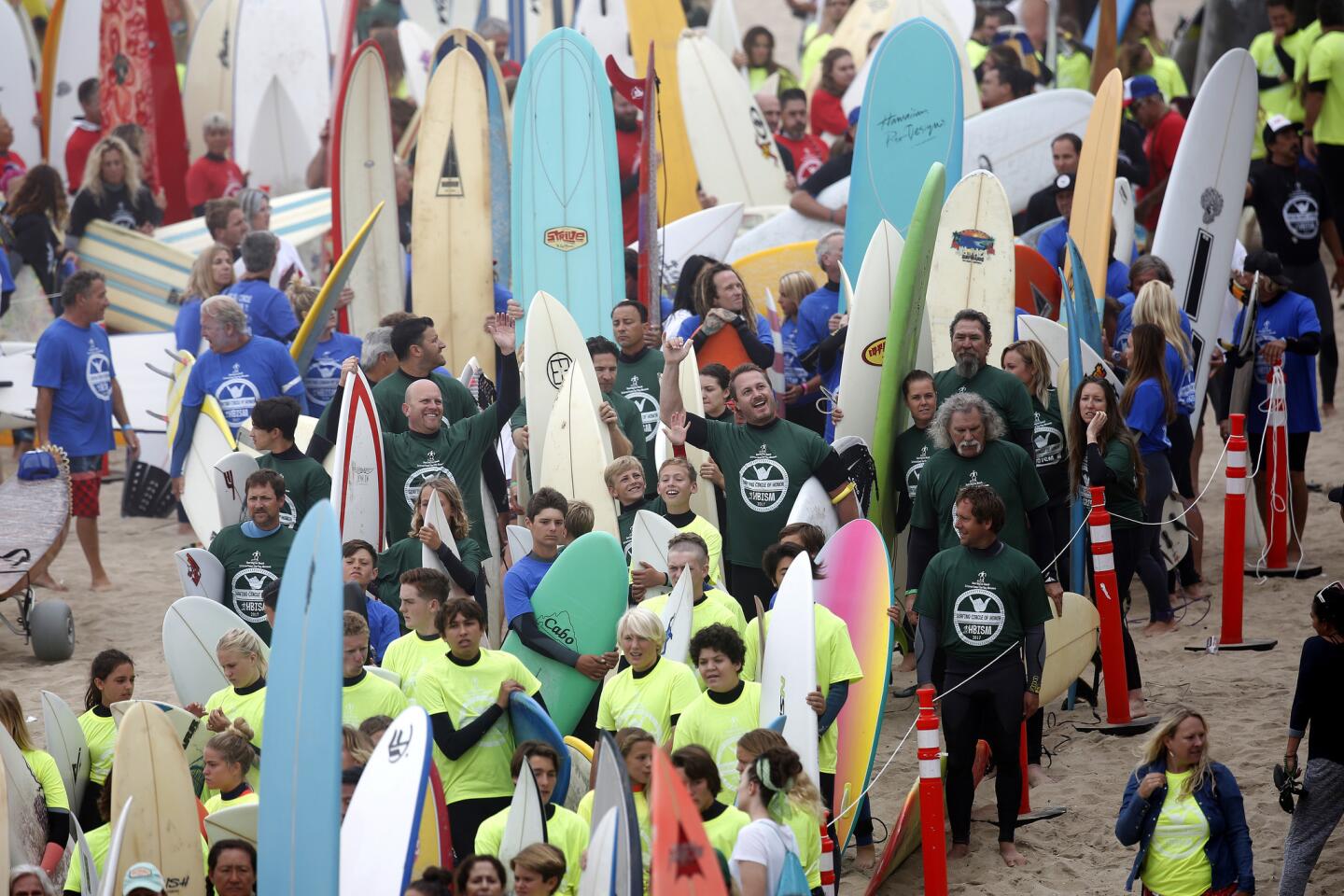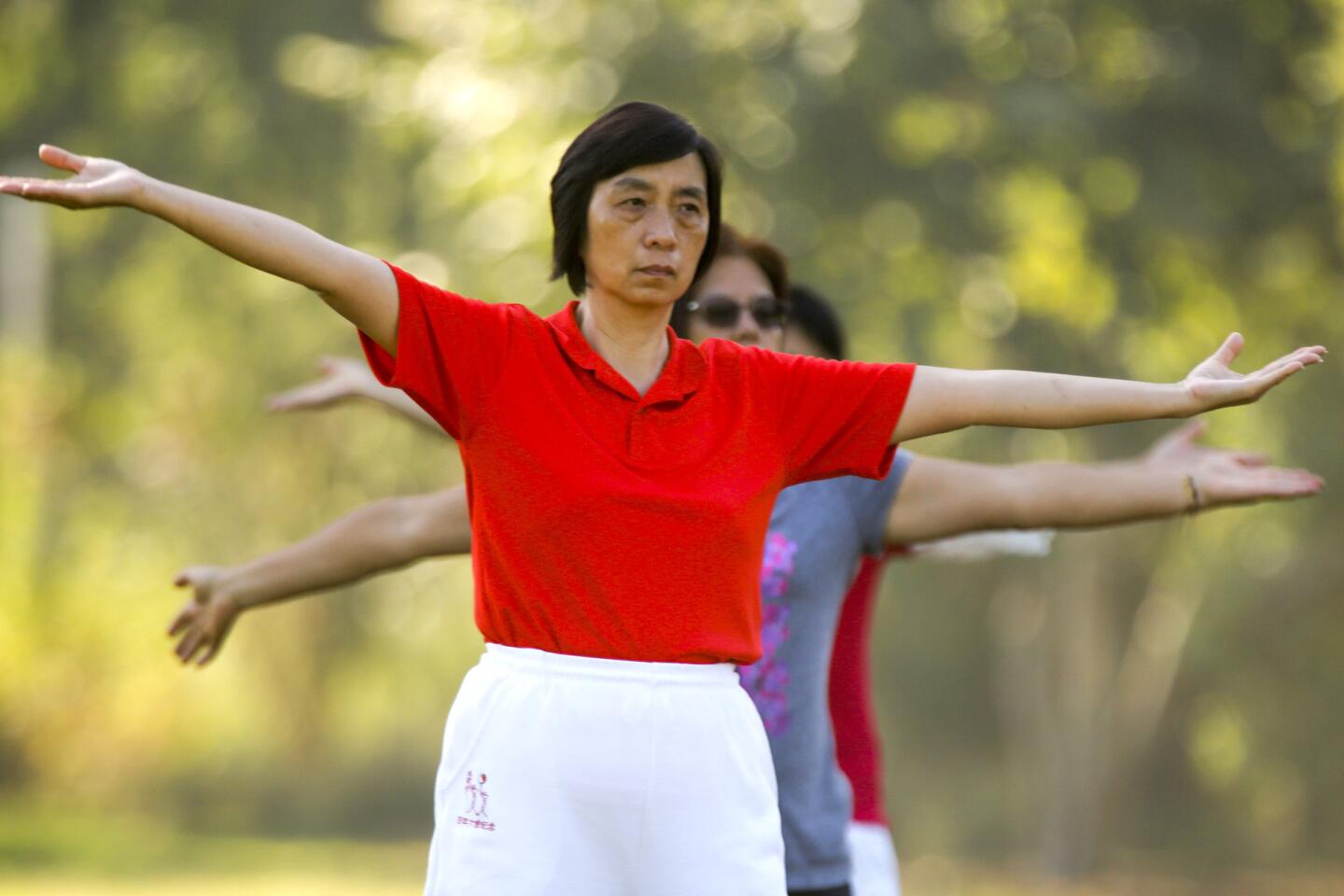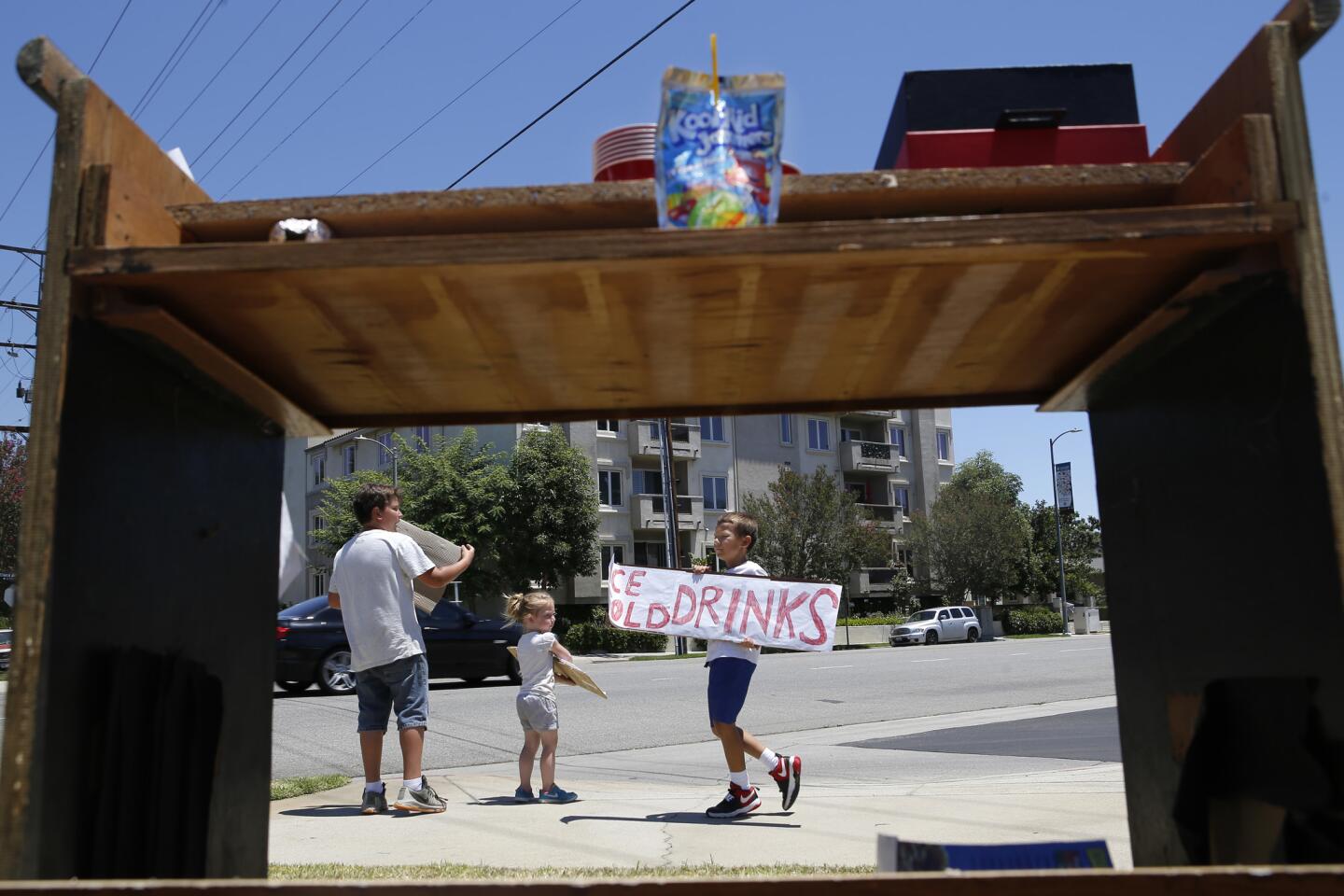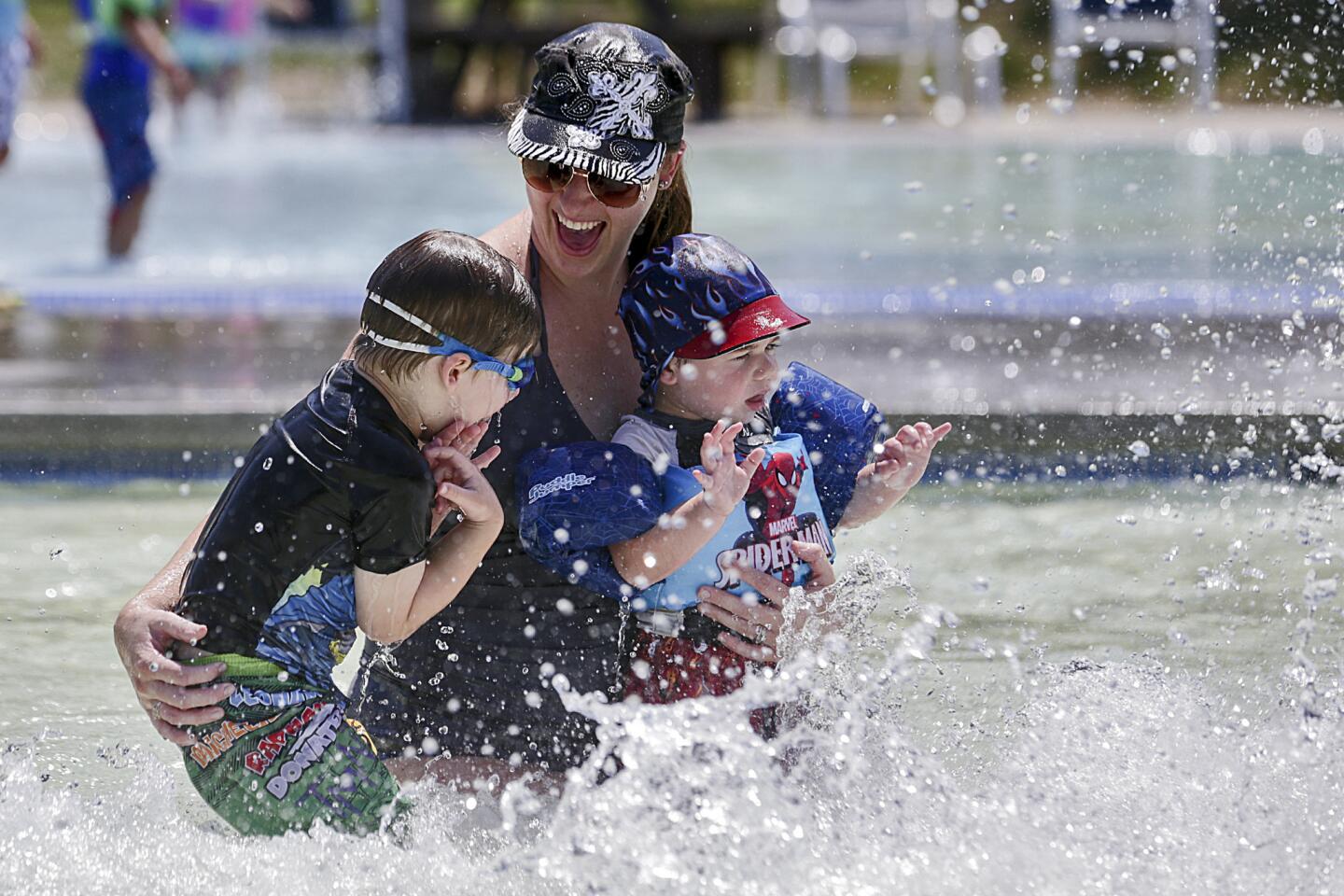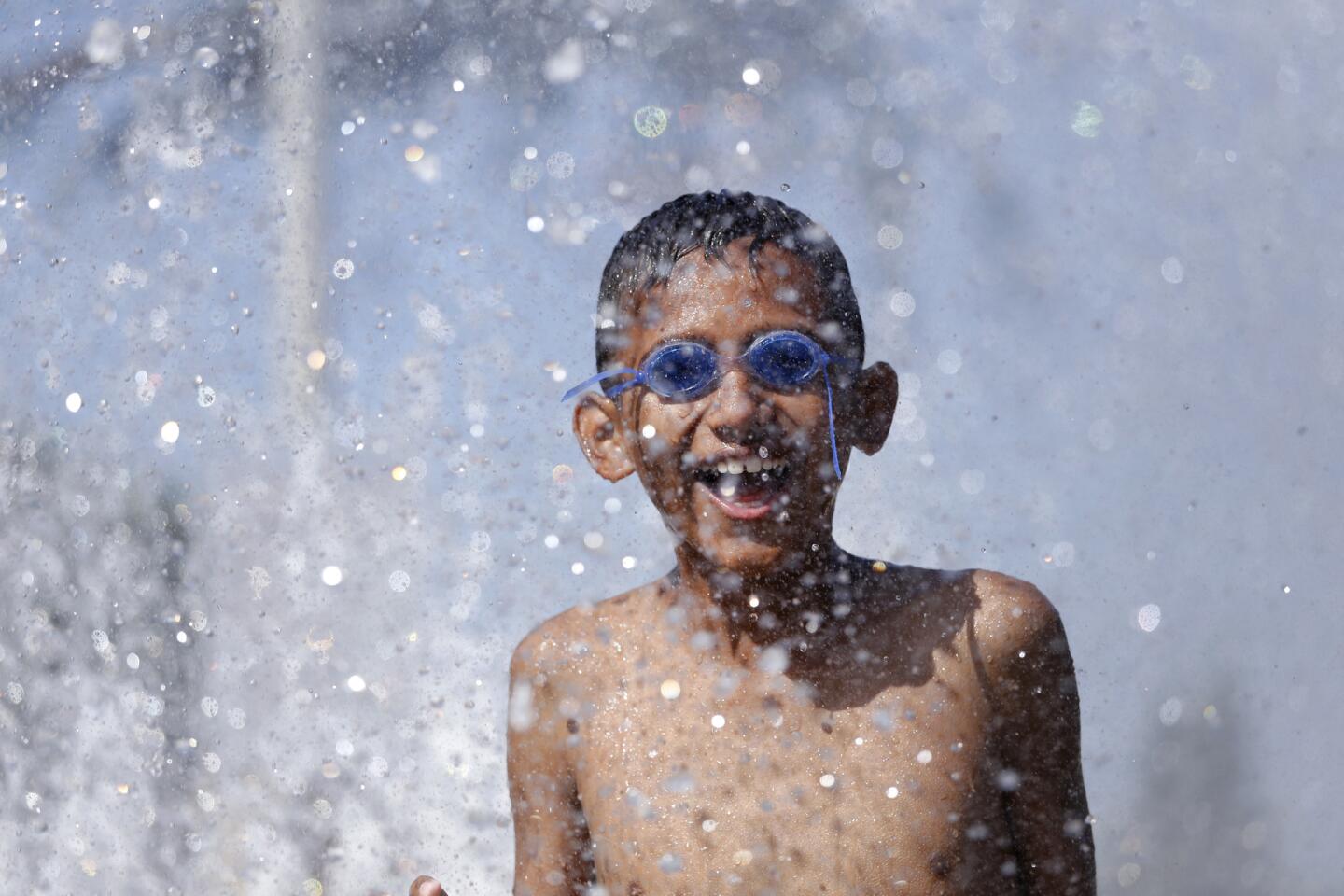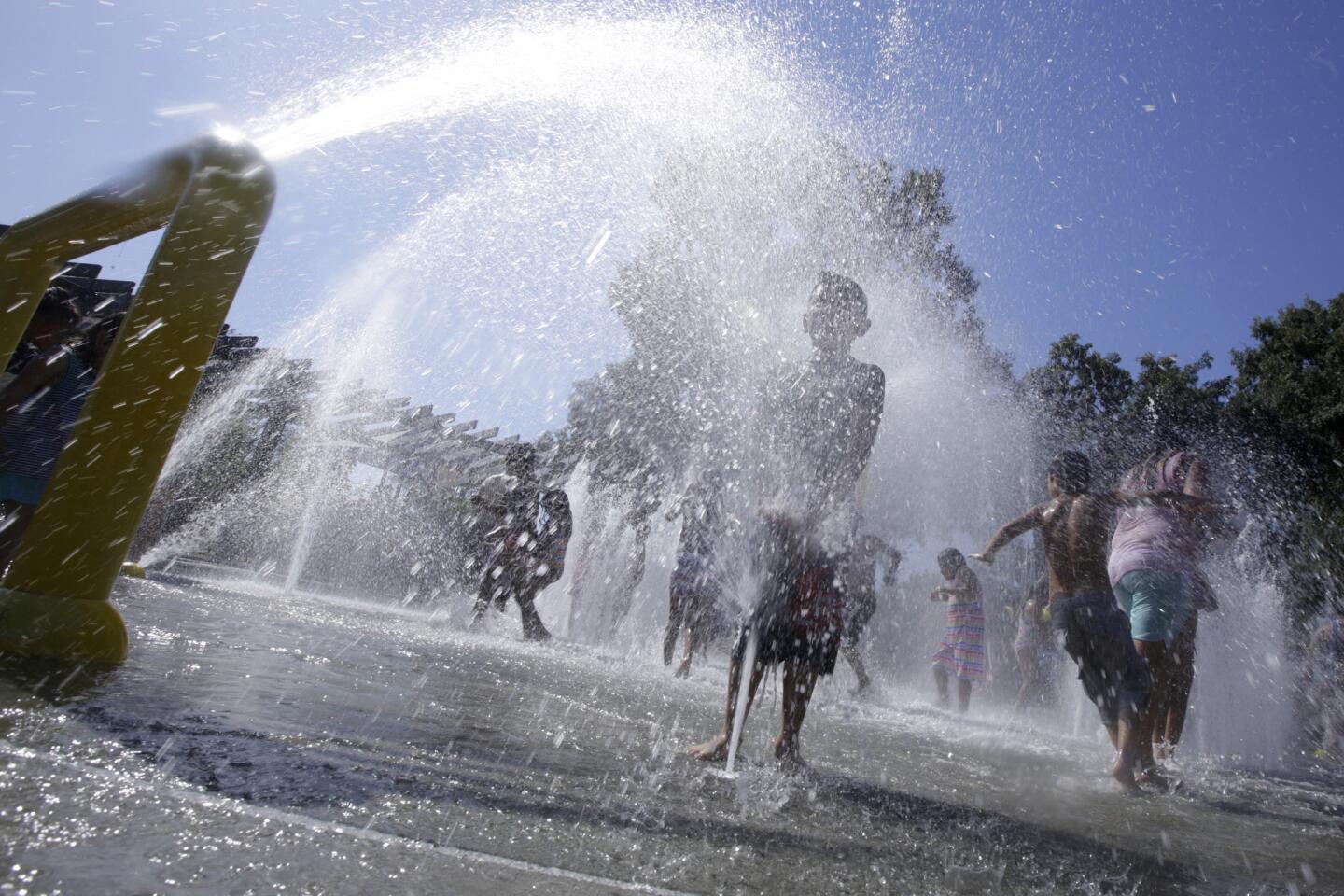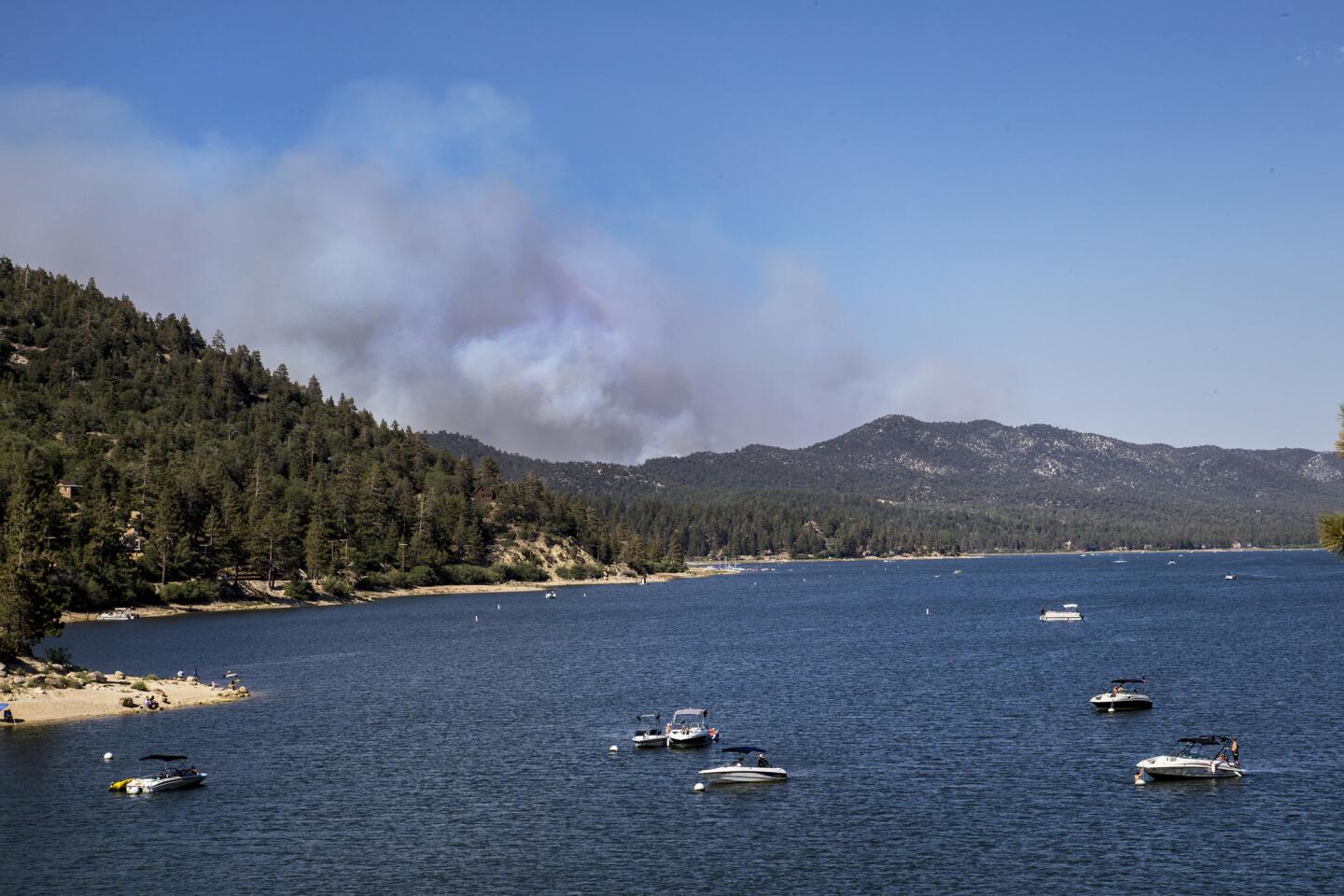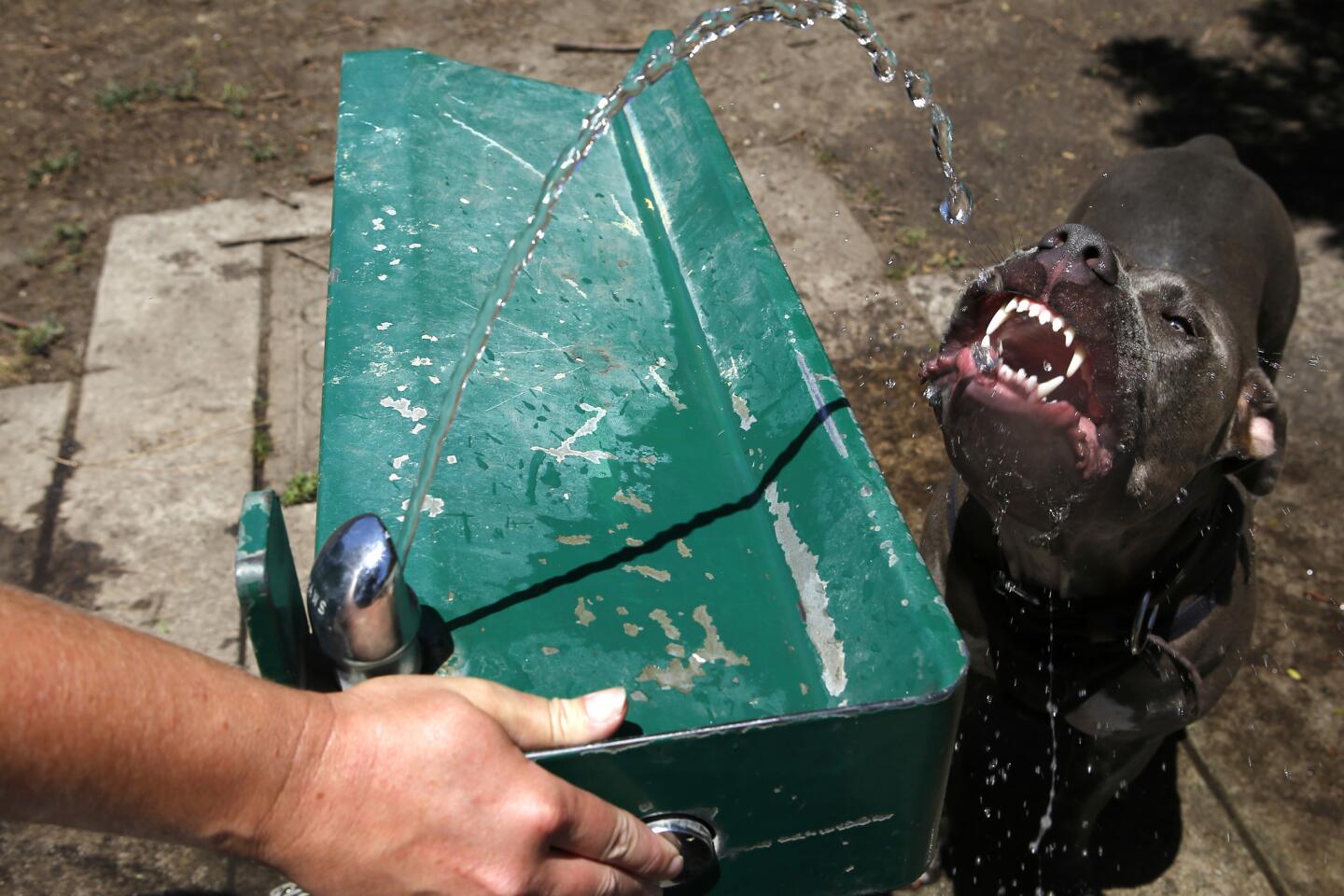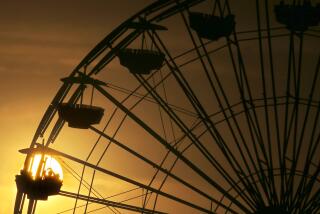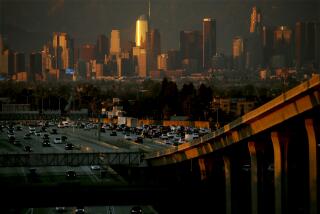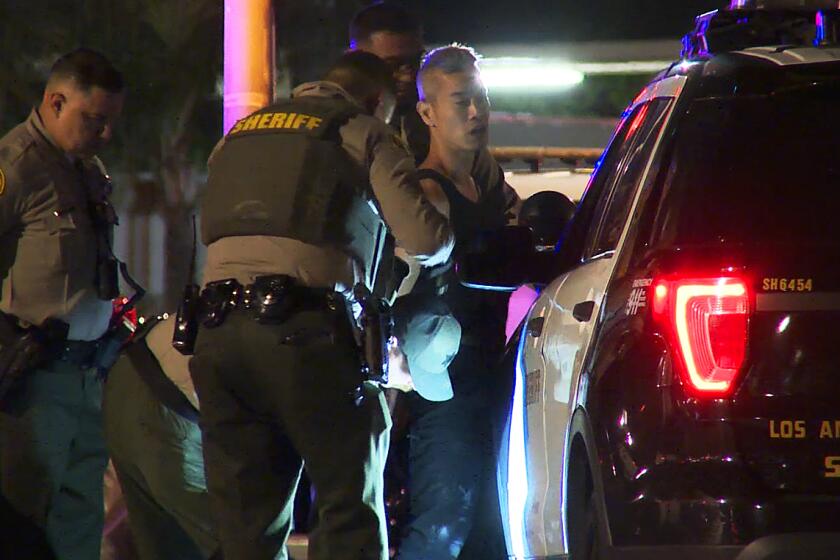The records are set up, ready to fall like dominoes if forecasters’ predictions prove accurate for Southern California’s heat wave this weekend.
On Friday, the National Weather Service expects heat records for July 7 in at least six parts of Los Angeles and Ventura counties to fall.
New records were set for the day in Palm Springs (122 degrees), Indio (119) and Thermal (121).
As of 3 p.m., downtown L.A. tied a heat record for the day, hitting 96 degrees. In Northern L.A. County, Sandberg set a new record for the day, 98 degrees.
1/46
The remains of a structure and boats scorched by the Whittier fire sit along State Route 154 in the Los Padres National Forest near Lake Cachuma in Santa Barbara County.
(Allen J. Schaben / Los Angeles Times) 2/46
The Whittier fire burns toward State Route 154 on Sunday in the Los Padres National Forest near Lake Cachuma in Santa Barbara County.
(Allen J. Schaben / Los Angeles Times) 3/46
Hundreds of people seek relief from the hot weather in the surf Sunday along the Santa Monica Pier.
(Genaro Molina / Los Angeles Times) 4/46
Hundreds of people seek relief from the hot weather Sunday near the Santa Monica Pier.
(Genaro Molina / Los Angeles Times) 5/46
A young girl tries to outrun the hot sand near Arlington West Santa Monica memorial on the north side of the Santa Monica Pier on Sunday.
(Genaro Molina / Los Angeles Times) 6/46
Hazmat workers inspect a storm drain after a Saturday night’s explosion at a Department of Water and Power station in Northridge. Thousands of gallons of mineral oil, a coolant, were sent down drains as firefighters used water to douse a burning transformer.
(Genaro Molina / Los Angeles Times) 7/46
A man wipes his face in front of his home on Logan Street in Los Angeles.
(Mel Melcon / Los Angeles Times) 8/46
A woman shields herself from the hot sun in 91 degree weather in Chinatown.
(Christina House / For The Times) 9/46
Jacob Martinez, 8, of Anaheim, waits for the water to turn on after a brief break to cool off in the spray pool at Lemon Park in Fullerton,
(Gary Coronado / Los Angeles Times) 10/46
The Whittier Fire burns on the north side of the Santa Inez Mountains near Goleta.
(Al Seib / Los Angeles Times) 11/46
A hot spot burns ahead of the Alamo fire near Santa Maria on Saturday, July 8, 2017.
(Luis Sinco / Los Angeles Times) 12/46
Firefighters look on as a helicopter drops water on the Alamo fire near Santa Maria on Saturday, July 8, 2017.
(Luis Sinco / Los Angeles Times) 13/46
A firefighter maneuvers his vehicle down a private road as the Alamo fire burns near Santa Maria on Saturday, July 8, 2017.
(Luis Sinco / Los Angeles Times) 14/46
Johnny Lewis, left, and his friend of over 50 years Earl Jackson, right, find refuge in the shade of an abadoned restaurant on Vermont and 54th in Los Angeles on Friday, during the region’s latest heat wave.
(Christina House / For The Times) 15/46
People brave record 110-degree temperature Friday while walking to work in West Hills in the San Fernando Valley.
(Al Seib / Los Angeles Times) 16/46
A visitor to Angels Gate Park in San Pedro watches the setting sun against a fiery sky at the end of a hot day in Southern California.
(Luis Sinco / Los Angeles Times) 17/46
Melissa Garcia, 6, cools off in the Reseda Park pool in the San Fernando Valley on Friday afternoon.
(Al Seib / Los Angeles Times) 18/46
Maricruz Garista, 17, cools off during a break from carp fishing with relatives at the Los Angeles River.
(Mel Melcon / Los Angeles Times) 19/46
People cool off in the spray pool at Lemon Park in Fullerton.
(Gary Coronado / Los Angeles Times) 20/46
The crowd waits for the water to return after a brief break in the spray pool at Fullerton’s Lemon Park.
(Gary Coronado / Los Angeles Times) 21/46
Kids cool off in the spray pool at Fullerton’s Lemon Park.
(Gary Coronado / Los Angeles Times) 22/46
A woman shields herself from the hot sun in 91 degree weather in Chinatown.
(Christina House / For the Times) 23/46
In Chinatown, pedestrians use umbrellas to shield themselves from the sun in 91 degree weather on Friday.
(Christina House / For the Times) 24/46
Jocelyn Caravantes, 3, left, and her brother Dean, 6, play in their Boyle Heights pool on a hot afternoon while their mother, Evelyn, watches from a chair in the shade.
(Rick Loomis / Los Angeles Times) 25/46
Swimmers dive from a pier at Kings Beach in Lake Tahoe, where temperature are expected in the mid 80’s today.
(Mark Boster / Los Angeles Times) 26/46
Darin Yoon, 12, endures the late afternoon sun as he sits with his father, John, at Dodger Stadium to watch the Dodgers and the Arizona Diamondbacks game.
(Robert Gauthier / Los Angeles Times) 27/46
Daniel Garcia rides around the Rose Bowl Loop Trail on a hot day in the Southland with temperatures expected to reach triple digits on Friday.
(Rick Loomis / Los Angeles Times) 28/46
Anthony Garcia, 7, cools off at the splash pad at Rio de Los Angeles State Park in Los Angeles.
(Gary Coronado / Los Angeles Times) 29/46
Firefighters extinguish a brush fire at Buena Vista Meadow in Elysian Park in Los Angeles.
(Gary Coronado / Los Angeles Times) 30/46
Maribel Vasquez cleans reserved level seats in the hot afternoon sunshine hours before the Dodgers and Arizona Diamondbacks game at Dodger Stadium.
(Robert Gauthier / Los Angeles Times) 31/46
A concertgoer prepares his spot for a free concert at Eastgate Park in Garden Grove.
(Glenn Koenig / Los Angeles Times) 32/46
Josh Peralta plays in water splashing in a fountain in Cathedral City, where temperature reached 118 degrees.
(Irfan Khan / Los Angeles Times) 33/46
Tina Robinson, left, and Eric Johns of Chicago beat the heat by walking under a cool mist and sipping colds drink in Palm Springs.
(Irfan Khan / Los Angeles Times) 34/46
Moises Lopez takes a water break from landscaping a San Gabriel Mission school to stay hydrated.
(Mark Boster / Los Angeles Times) 35/46
Lincoln watches over pet owner Michelle Virney while she takes a nap to cool off in Vincent Lugo Park in San Gabriel.
(Mark Boster / Los Angeles Times) 36/46
Surfers set a mark recognized by the Guinness World Records for the largest paddle-out on International Surfing Day.
(Gary Coronado / Los Angeles Times) 37/46
Surfers line up before attempting to set a mark recognized by the Guinness World Records for the largest paddle-out, forming the Surfing Circle of Honor on International Surfing Day.
(Gary Coronado / Los Angeles Times) 38/46
Umbrellas are required equipment while walking around Vincent Lugo Park as temperatures rise during the latest heat wave.
(Mark Boster / Los Angeles Times) 39/46
To beat the heat, Lily Lin leads an early morning Tai Chi class at Vincent Lugo Park in San Gabriel.
(Mark Boster / Los Angeles Times) 40/46
From left, Aaron Stevens, 11, Alida Stevens, 4, and Brian Botts, 9, wave down customers as they sale refreshments on a hot summer day in Van Nuys. “We want to help people hydrate while helping ourselves,” Aaron Stevens said.
(Christian K. Lee / Los Angeles Times) 41/46
Brian Botts, left, and Aaron Stevens, right, prepare a cup of Kool-Aid for Carlos Zepeda in Van Nuys.
(Christian K. Lee / Los Angeles Times) 42/46
Tawny Auer joins her sons Shane, left, and Carter to cool off in a pool at the aquatic center in Palm Desert, where temperature reached 115 degrees.
(Irfan Khan / Los Angeles Times) 43/46
Adrian Rosales cools off at the spray pool at Lemon Park in Fullerton.
(Glenn Koenig / Los Angeles Times ) 44/46
Children splash in water from the spray pool at Lemon Park in Fullerton.
(Glenn Koenig / Los Angeles Times ) 45/46
Boaters relax on Big Bear Lake as a giant plume from the Holcomb fire burns nearby in rugged terrain in the San Bernardino National Forest.
(Gina Ferazzi / Los Angeles Times) 46/46
Luigi, a thirsty pit bull, cools down at Genesee Avenue Park in Los Angeles.
(Christian K. Lee / Los Angeles Times) Some of the areas that are traditionally hottest in L.A. County, such as Woodland Hills, may have consecutive days of record-setting temperatures. Woodland Hills is expected to reach 112 degrees Friday and Saturday, which would break and tie records for those respective days set in 2006 and 1985, the forecast stated.
As a result, the National Weather Service said there is a critical fire danger in the coastal mountains and foothills as well as an excessive-heat warning inland.
Members of the public were urged to avoid being outside directly under the sun in the midafternoon, and told to drink lots of water and to wear light-colored, lightweight clothing through the weekend.
The homeless, the elderly, infants, and people who work outdoors are particularly vulnerable to heat-related illnesses, officials said.
Los Angeles County’s cooling centers are listed here.
Humans aren’t the only ones who suffer in a heat wave. Pets can also be vulnerable to the sweltering conditions and can die if left in a vehicle for even a short time.
When it’s 80 degrees outside, the inside of a car can heat up to 99 degrees in 10 minutes and climb up to 114 degrees in half an hour, the weather service said. A law that took effect this year allows Californians to break into vehicles to rescue animals if they appear to be in danger of excessive heat.
Of course, this being summer in L.A., the extra heat isn’t shocking. But Bill Patzert, a climatologist for the Jet Propulsion Laboratory, said the heat waves are “definitely coming earlier this year.”
Southern California typically sees its warmest weather in August or September, he said.
The sizzling temperatures are the result of a jet stream that brings cooler weather to the California coast, moving north due to the position of the sun relative to the Earth in summer, Patzert said.
That shift produces the American Southwest monsoon, in which high pressure settles over the Four Corners region of the U.S. — where Arizona, Utah, New Mexico and Colorado meet — and pulls in tropical moisture from the Gulf of California and warm air from the Mexican desert.
The system is currently settled over the desert in the Southwest and spreading sweltering temperatures from California to Oregon and as far east as central Texas.
The mixture of heat and humidity makes it difficult for the human body to insulate itself from the heat in the shade. It also increases the chances of thunderstorms that will produce dry lightning and spark wildfires.
“This one is more intense than we saw in June … and so the danger to the vulnerable just got maxed up,” Patzert said of the heat wave.
joseph.serna@latimes.com
Twitter: @JosephSerna
ALSO
Amber Alert issued after 16-year-old boy is abducted by woman in Los Angeles
Animal control officers uncover 80 snakes and a pool full of alligators at Thousand Oaks home
Malnourished 5-year-old found in chains in Mexico may be returned to U.S.
UPDATES:
4:40 p.m.: Updates with Palm Springs record.
3:29 p.m.: This article was updated with information about afternoon temperatures.
11:40 a.m.: This article was updated with authorities’ suggestions on dealing with the heat.
This article was originally published at 6:40 a.m.


